|
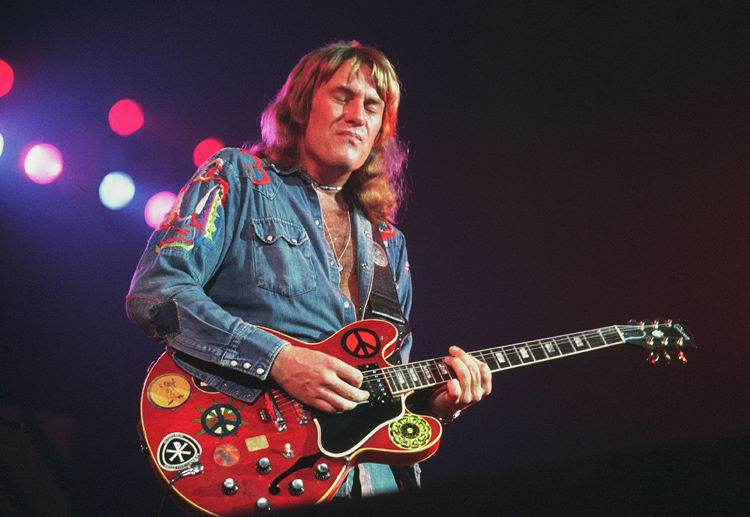
Alvin Lee and Ten Years After at the
Chicago Amphitheater 1975
Photographer: Jim Summaria -
www.jumsummariaphoto.com
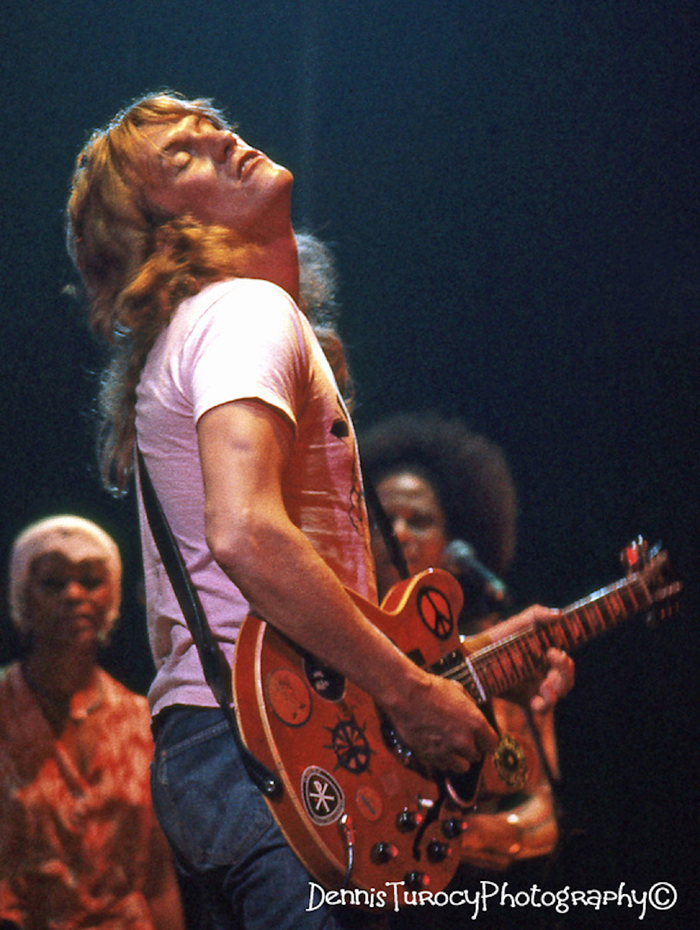
January 16, Alvin Lee & Co., Pittsburgh
Syria Mosque - Photo: Dennis Turocy
|
January 18,
1975 – At The Academy of Music – New York, NY
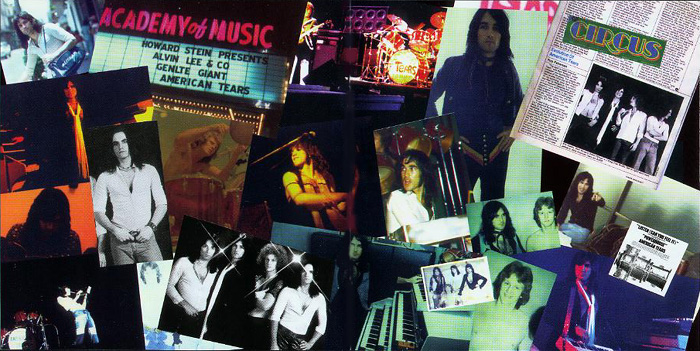
On Bill Are –
Alvin Lee & Co – Gentle Giant – American Tears
American Tears,
were a “Power Keyboard Trio” who recorded three albums
for Columbia Records during the mid 1970’s. Their music
ranged from progressive and symphonic rock, to keyboard
oriented “Pop” songs of the era, as the band emphasized
adventuresome arrangements and musicianship. On their
third album “Powerhouse” they added a guitarist, Craig
Brooks, which gave them access to large vocal harmonies
and ultimately evolved into the band “Touch”. Touch
recorded two albums for Atlantic Records – While all
three of the American Tears albums are now available on
CD format. “Powerhouse” Japan Import also includes the
band’s second “single” – “Born To Love”. Their three
albums are: Branded Bad – Tear Gas – Powerhouse 1977.
Out of American Tears came the band “Touch” in 1978
Mark Mangold –
Keyboards / Songwriter – Glen Kithcart – Drums and Craig
Brooks all guitars. The line-up was completed by adding
bassist Doug Howard. Mark Mangold, in collaboration with
Michael Bolton composed the song, “I Found Someone” was
recorded by Laura Branigan – but ultimately became a big
top ten hit for Cher.
From Dave: I recommend American Tears “Powerhouse”. I
bought the record brand new back in 1977, having never
heard of this band before. I was so impressed, that 34
years later I just bought the Japanese import on cd, and
it still sounds as fresh and new as ever. Sure it’s as
much pop, rock and ballad as much of the middle to late
1970’s was, except this album was something special –
for what it didn’t have on it – excess! It’s tasty, not
sappy and with enough rock hooks, licks and energy to
make it enjoyable and memorable. It’s like finding an
old friend once again – welcome back my friend! |
January 19, 1975 - Alvin Lee & Co.
at Lisner Auditorium,
George
Washington University, Washington, DC
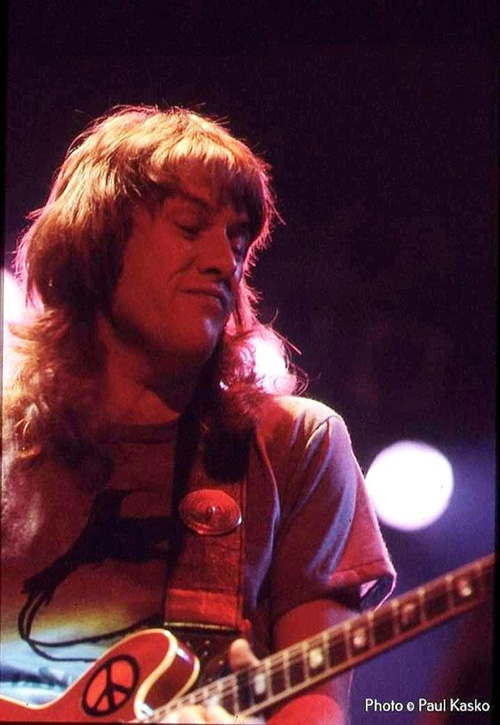
Photos: Paul Kasko

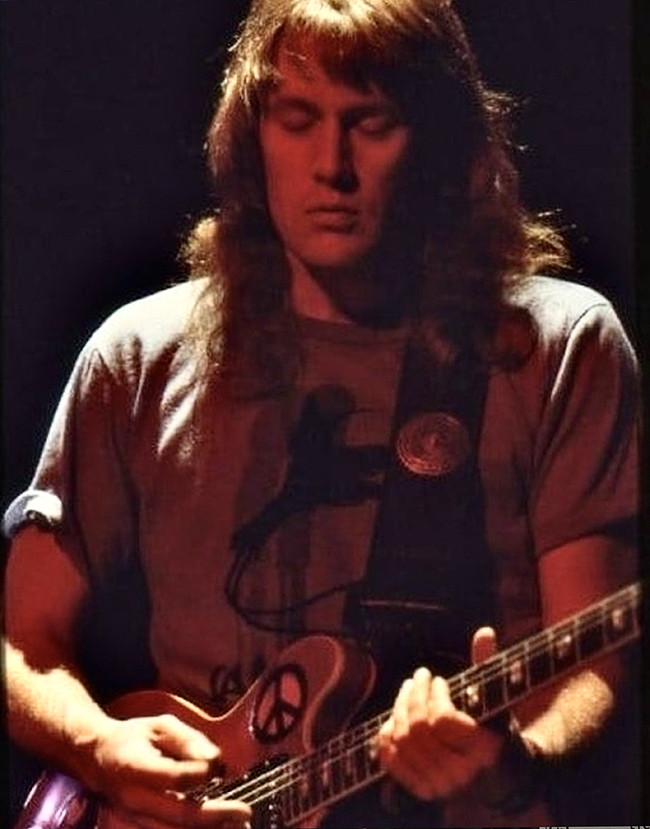
Photo: Paul Kasko

January 28, 1975 - Alvin Lee & Co. at
The Auditorium Theatre, Chicago
January 1975 -
BEST Magazine, France

Front Page

page 26 & 27
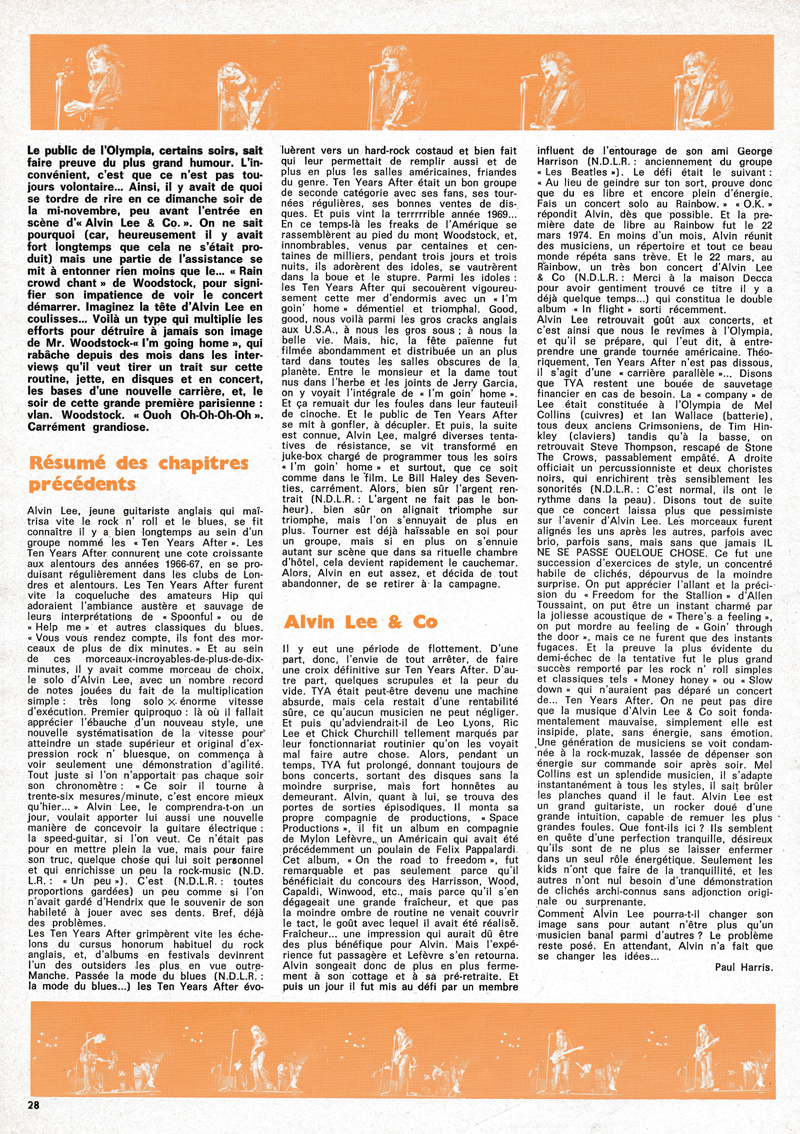
page 28
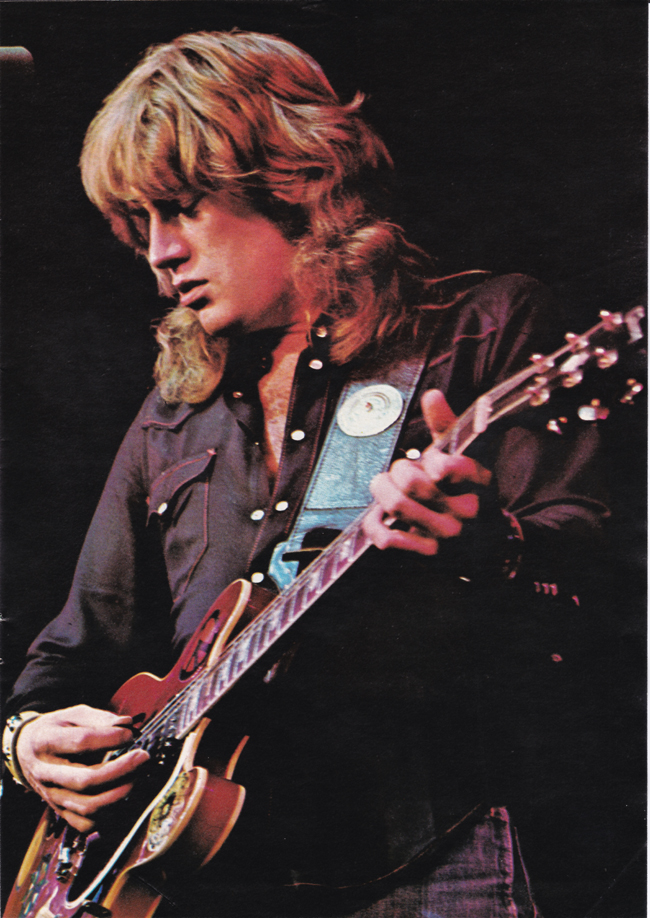
page 29
January 1975 -
BEAT INSTRUMENTAL Magazine, England
"In Flight"
Album Review

January 31, 1975 - Alvin Lee &
Co.,
Norman Oklahoma,
Field House At University Of Oklahoma
  

February 12, 1975 - Alvin
Lee, backstage at Paramount Theatre, Seattle
Photo: Brad Matisoff
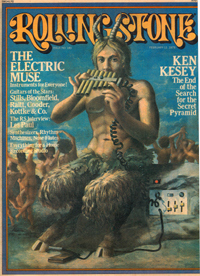
ROLLING STONE
February 13,
1975

With Ten Years After behind him, Alvin Lee finds
his way with Alvin Lee Company
London---Alvin
Lee is on the road again, and this time he’s not going
home. Inspired by a special London concert
last
March without Ten Years After behind him, Lee bid an
indefinite good-bye to his colleagues of seven years.
Ten
Years After might someday work together again, he says,
but the immediate future belongs to a new band called
Alvin
Lee and Company. They are now on a six-week U.S. tour, and
Lee’s Rainbow Theatre concert has been
released
as an album, In Flight. “Well, Lee says, grinning in the
corridor of his countryside home, a gold record
for
the Woodstock album hanging overhead, “I’m certainly
not going to be playing “I’m Going Home.”
In
a sense Lee is home, playing the kind of music that earned
him that first initial recognition. The new band
creates
a sense of déjà vu, all of the players going back to
their roots. There’s bassist Steve Thompson and
keyboard
player Ronnie Leahy, former member of Stone the Crows,
Maggie Bell’s starting ground. Drummer
Ian
Wallace and reed player Mel Collins are former members of
King Crimson and have contributed to
numerous albums. A percussionist and several backup singers
complete the group.
The
rejuvenation of Alvin Lee as a musician started before the
London concert with an album with Mylon
LeFevre,
On the Road to Freedom, the first step out of the musical
prison TYA had become.
“It
got to feel like an old marriage. I started to get the
seven-year itch. I wanted a band,” he says, “I
didn’t want
it
to be Alvin Lee showing off his clever tricks, which is
what was beginning to happen with TYA. It all became too
mechanical.”
The
machinelike atmosphere became oppressive during the
band’s last American tour. “It got to the point where
American
tours were boring. It was too much like a job; the fun was
gone. Everything ran too smoothly. It was
just
an endless cycle of tours and albums. On that last
American tour it got so bad that each day I’d look
forward
to
a different airline, a different colour scheme, a higher
hotel than the night before.” TYA began to feel like a
treadmill,
just
what Alvin wanted to escape through music. Before
Woodstock, TYA was just another entertaining British blues
band dabbling in jazz. After the infamous three-day
festival the band—Alvin in particular—was elevated to
superstar status, confined to a set pattern.
“Yeah,”
Lee shrugs. “We were a different band before Woodstock.
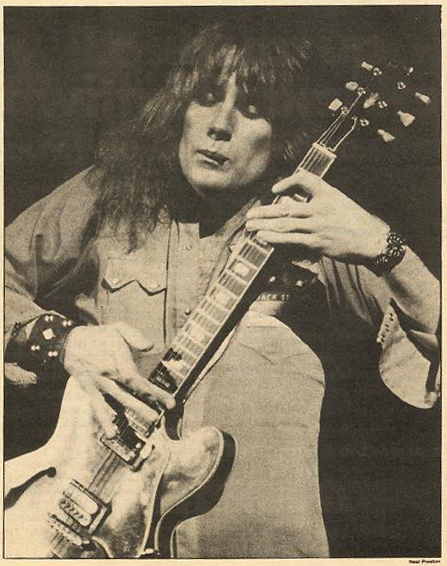
We’d play the old Fillmore and be able to just play.
We
had a respectful audiences then who would appreciate a jam
or a swing. But after Woodstock,” he winces,
“the
audience got very noisy and only wanted to hear things
like “I’m Going Home.” “I’ve always been much
more of
a guitar picker but I began to feel forced into a position
of being the epitome of a rock & roll guitarist.
Originally
TYA wanted to make it without having to compromise to pop.
It worked for a while but
after
five or six years the fun went out of it for me, a lot of
the music went out of it. And, he smiles shyly,
“all
I wanted to be was a musician. With this new band I feel
relaxed. I have enough freedom that I don’t feel
pigeonholed anymore.
“Everyone
thinks of the group as my solo thing but I think of it as
a band. Everyone in the group is free,
everyone
is their own musician. It’s up to each individual what
they play. “This band is just good fun. The
excitement
of not knowing what will happen next is great; it’s a
welcome change. It really is like going back to
the roots; feeling enjoyment in the music again is how TYA used to feel.”
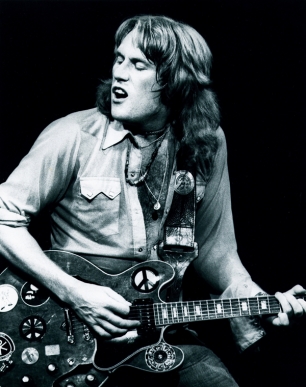
On
their recent European trek, audiences shouted for the band
to boogie, and to play TYA standards, but
were quickly pacified by the new music. Standing out front,
Alvin Lee taps his foot gently and takes time
finding
the right notes. Gone are the bullet like barrages of
lightning-fast solos, the archetypal superstar
Grimaces
, replaced by fluid playing and an anonymous grin. The
material is strictly non-TYA.
“Even
though the songs are mine, it’s the music of the band. I
guide a lot of it but it’s still down to the group.
“One
might get the impression that this time around the
guitarist does not dominate the proceedings. “If
anything, Mel gets his freedom he steers the band toward a
kind of nouveau jazz, bordering on the
realms
of John Coltrane, Chick Corea and Herbie Hancock- type
number and then something like Money Honey.
That’s
the kind of musical freedom I like: jazz, rock, blues,
anything. “You adopt different attitudes when you
Play
different music. This band is more reserved, more
disciplined, more tasteful. But the discipline is good. If
everyone
were to race off on their own solo it would be a mess. My
solos are more tastefully conceived now,”
he
nods his head in agreement. “But I still get going in
places. It’s just that I build up to it now. I don’t
race
off
on a solo. I take my time.”
While
TYA remains in a state of permanent limbo, this band
exists at the least through spring. On return
from
the American tour, they will record an album. But Lee is
quick to add that there might be changes:
possibly
another album with Mylon, perhaps a tour.
Alvin
Lee refuses to commit himself anymore.
By
Barbara Charone
|
|
Ric of Ten Years After Returns: 1975 Newspaper Article
From the country that helped
produce Alvin Stardust and Paper Lace comes yet another
group now internationally renowned – Ten Years After. And
drummer Ric Lee, one of two members of the group born in
Mansfield, recently returned to his home town to give an
exhibition of his drumming ability at the Swan Hotel,
Mansfield. Ric aged 30, now lives in a large house
standing in a leafy 20 acres in Kent, and he made the trip
up to Mansfield to Promote Premier Drums in a
demonstration organised by the Carlsbro Sounds Centre Ltd.
Station Street Mansfield.
Ric performed a self penned drum solo and spent a short
time signing autographs and answering questions. Ten Years
After is comprised of Ric Lee, Alvin Lee, Chick Churchill
and Leo Lyons, who is also from Mansfield. Last week the
group gave a concert in Sheffield, after which they left
for a tour of America.
|
|
February 14, 1975
- Los Angeles FREE PRESS

By Tim Hogan
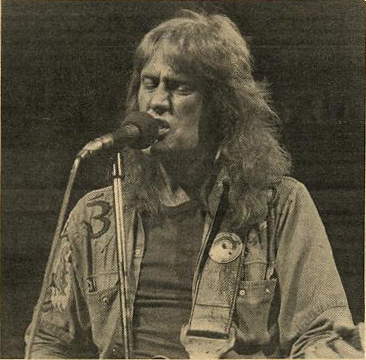
Ten Years After
never made it to the ten year mark! The results of Ten
Years After’s eight year tenure as the foremost British
boogie-band are in, and history may well record them as a
rock `n´ roll tragedy. “The kind of music we were playing
became a trap,” says Alvin Lee captured for a brief
interlude during his extended debut, U.S. tour as leader
of Alvin Lee and Company. “It got to be a trap right after
Woodstock. The movie made “I’m Going Home” too big for its
own good. It put too much weight on that aspect of the
band, until that became the only aspect of the band.
People expected “I’m Going Home” and boogie-boogie and
bash-bash”. The Woodstock movie, with it’s lengthy segment
of Lee sensually squeezing elongated chop – riffs from his
guitar catapulted Ten Years After into the ranks of
superstardom.
But Lee, the only
surviving member of the band musically, found that aspect
of music’s rewards to be frightening. It drove him into
being a recluse. “I could never play the part,” said Lee,
as he disappeared into the comforts of his baronial
mansion in England’s Berkshire countryside. It took the
renewal of Lee’s friendship with Mylon LeFevre, a
southern-fried gospel major, to lift him from his self
styled pit of depression. “Mylon sort of gave me the
gospel, in that he told me that I had a talent that I
should be using. The result of this rekindled fire was the
Lee – LeFevre album called, “On The Road To Freedom” 1973,
which did more for bringing Alvin back out into the world
than it did in the category of record sales.
The album,
featuring Lee in his first dose of acoustic country styled
music, was an instant sleeper; straight into the bargain
bins it went. “The thing was, I was trying to change with
the same influences around me. Working with Mylon, gave me
new influence and the ability to change a new environment.
I learned to enjoy the challenge of change”.
But business
before pleasure, and we soon find Alvin Lee trapped into
more Ten Years After records and touring, and last year’s
May Ten Years After tour drove the point home with
vengeance. “I remember one small incident that really
stuck in my mind. There was a black couple, about eight
rows back in the middle of the audience, really getting
off, I kind of play to them in a way. I was really
grooving on it. And then came “I’m Going Home” and the
whole crowd sort of rushed the stage, and this guy’s chick
was knocked on the floor and he had to fight for his
chick’s life. And I figured he probably wouldn’t ever come
to a gig like that again, as much as he likes the music,
because of all the hassle”.
Ten Years After
had it’s own identity to cope with. “I always thought of
Ten Years After as four people who almost fought together
to make music. It was really violent and driving, and a
lot of people do like that. In fact, I like it myself, but
not all the while. The worst thing about Ten Years After
was they didn’t have any enthusiasm about playing. It was
just a job”.
It took a dare
from George Harrison’s aide-de-camp, Terry Doran, to get
Lee back into the music world after that last Ten Years
After tour. Lee had again retired and was one day sitting
around the Harrison homestead, when Doran challenged Lee
to get off his ass and do something. “I can do whatever I
want, when I want,” said Lee. “No you can’t” teased Doran,
and Lee retorted, “Yes I Can” back and forth until Lee had
committed himself to doing something. The result was much
like the initial indications on a seismograph that
something big was coming. Four weeks later, Alvin had
drawn together some of the best available musicians under
the banner, Alvin Lee and Company. A date at London’s
Rainbow Theatre was booked and once again Alvin was out of
retirement. The concert was recorded and released as Lee’s
latest Columbia effort, “In Flight”.
The momentum from
that concert resulted in Lee agreeing to take the company
out on the road, and its been one hell-of-an experience
for Alvin who was a prisoner of his own imagination. With
slightly altered personnel from that on the LP, Lee hit
the road in January on a tour that’s been extended several
weeks because of the high level of enthusiasm that the
band has met with, and this new unit is no rehashed Ten
Years After.
“This band is a
funky band,” explains Lee. “What we’re after now is to do
some acoustic numbers, some jazz numbers, basically to add
some depth to our performance. I can nip in and nip out, I
don’t have to keep playing rhythm all the time. There’s a
lot more variety and I think it will appeal to a wider
variety of people. The music is changing and so am I”.
 And Doran’s
challenge to Lee has resulted in Lee coming out more as a
musician. Early this year, he found himself in Nashville,
working with Earl Scruggs on his anniversary LP, along
with Charlie Daniels, Billy Joel, Tony Joe White, The
Scruggs Brothers, Reggie Young and Bonnie Bramlett.
Another LP with Mylon is tentatively set for some time in
1976, and he expects to return to England at the end of
this tour. And Doran’s
challenge to Lee has resulted in Lee coming out more as a
musician. Early this year, he found himself in Nashville,
working with Earl Scruggs on his anniversary LP, along
with Charlie Daniels, Billy Joel, Tony Joe White, The
Scruggs Brothers, Reggie Young and Bonnie Bramlett.
Another LP with Mylon is tentatively set for some time in
1976, and he expects to return to England at the end of
this tour.
The door is open and Alvin Lee is walking tall. “Win or
lose, I’m enjoying it”. |
1975, February 14 -
Winterland, San Francisco
Alvin Lee & Co. - Photographer:
Dan Cuny
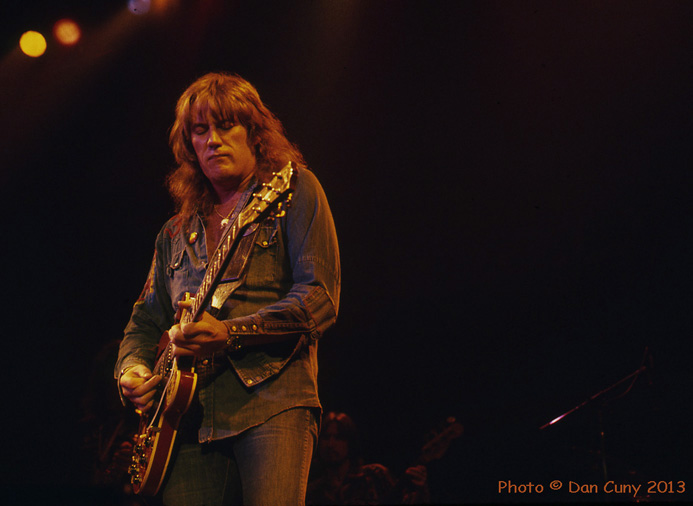
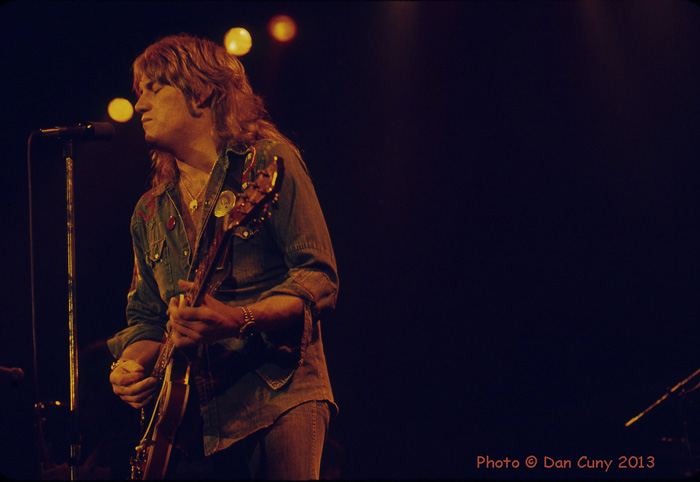

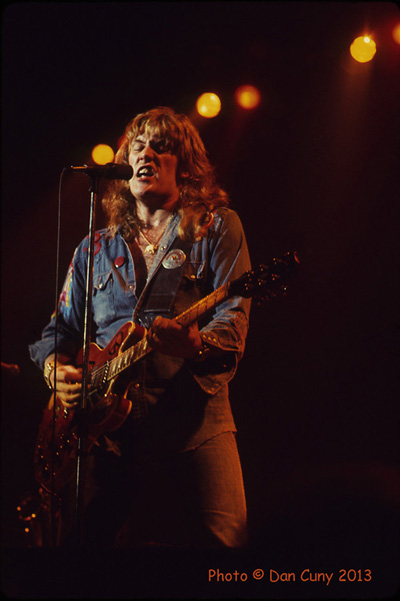
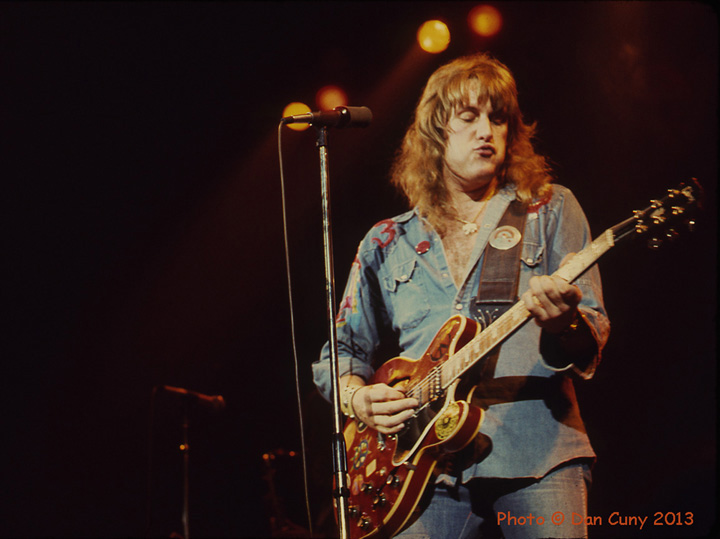


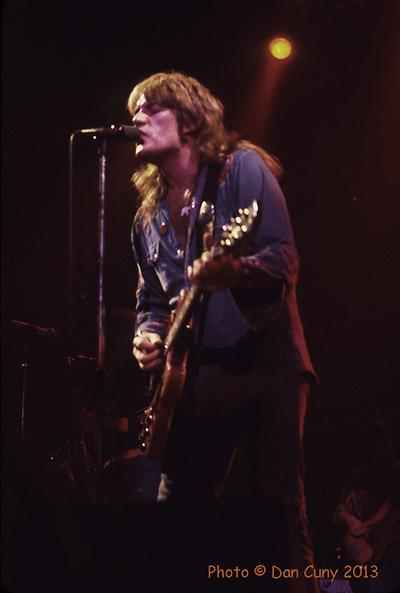
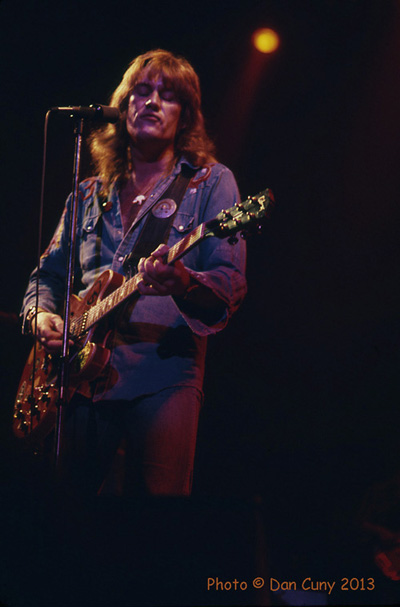
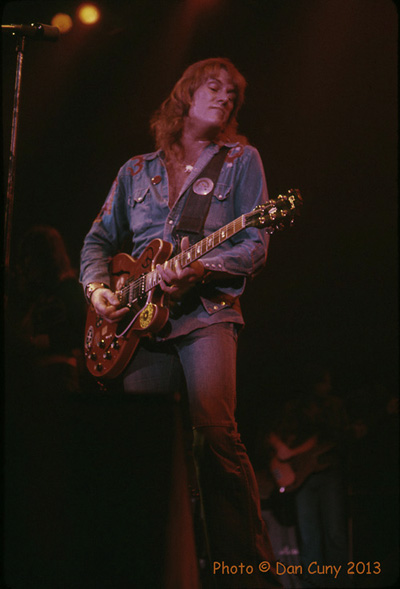
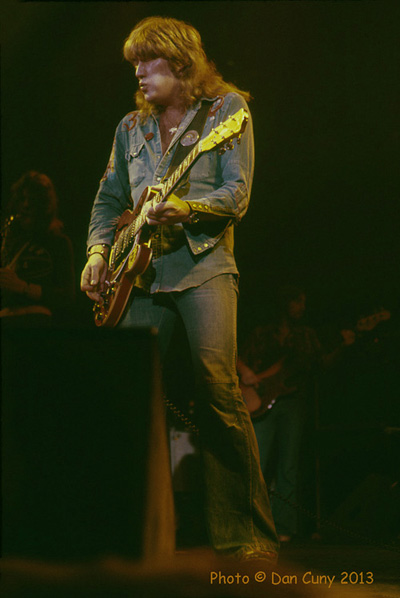

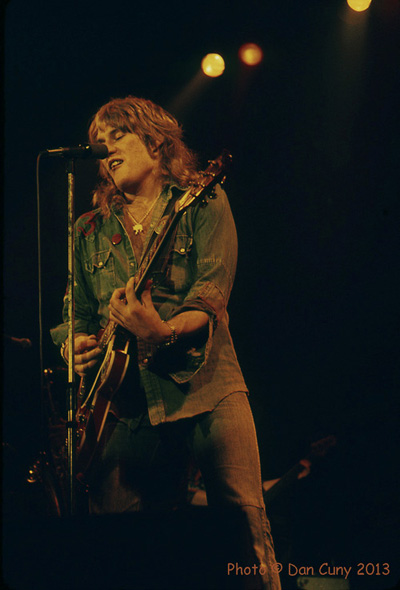
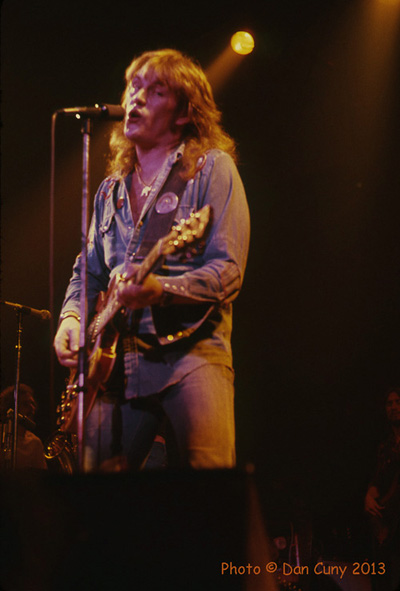
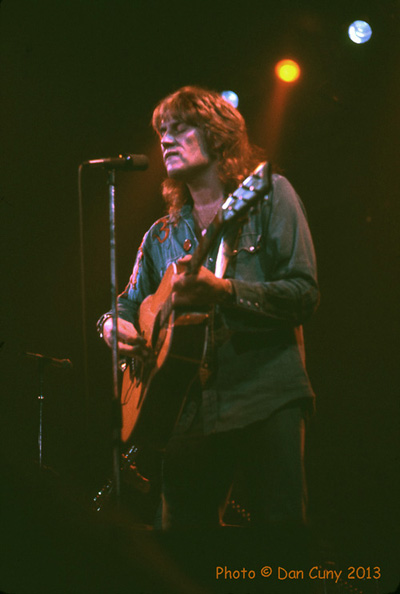
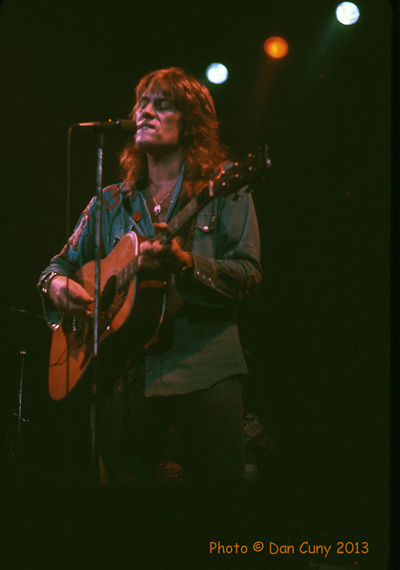
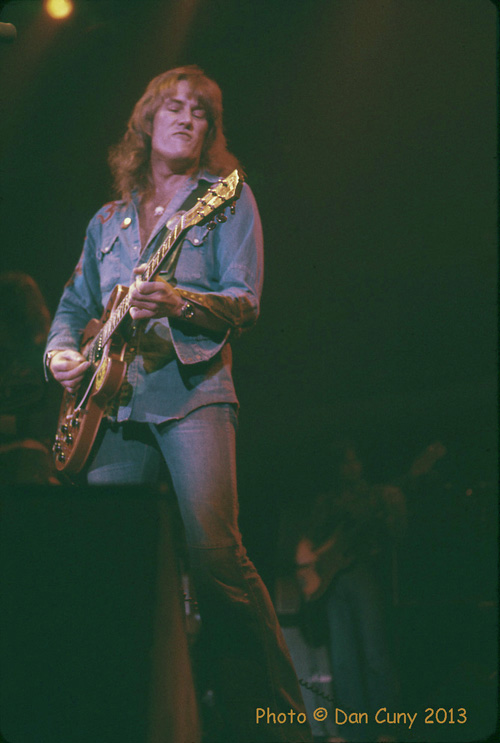
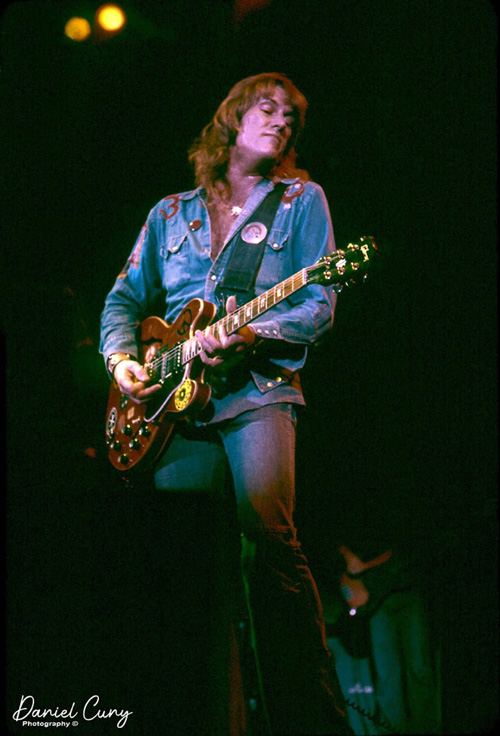
Photos by Daniel Cuny - Website:
https://www.dancuny.com

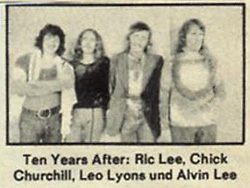
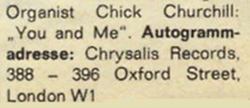
BRAVO Magazine - March 6, 1975
|

Many Thanks to
Claudia Staehr for the above article (Herb Staehr's
collection)
 |
|
March 21, 1975 -
Alvin Lee & Co. at TV Show "Midnight Special"
NBC
Studios, Burbank, CA
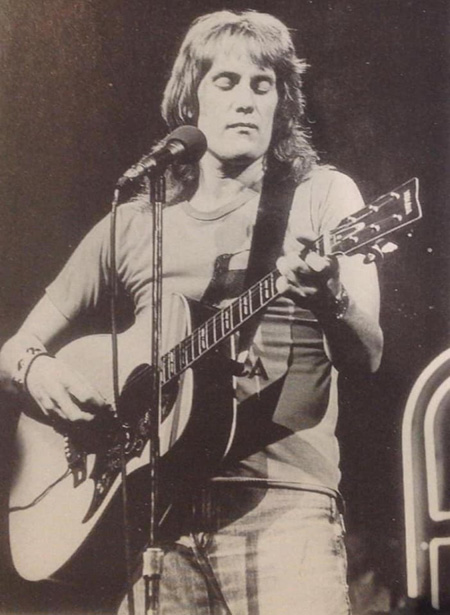
Photo: Jon Levicke

21 March
1975 - Alvin Lee & Co. at "The Midnight
Special" TV Show
|
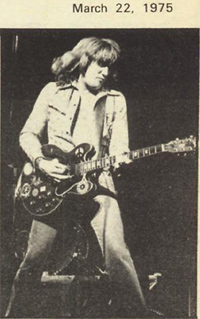
New
Musical Express
March 22, 1975
Alvin Lee is continuing to work as a soloist, while
Ten Years After remain active, and this week finds him
on the road undertaking his first ever British tour with
his own band. With a line up comprising former members
of Stone The Crows – King Crimson. Alvin Lee &
Company have dates during this gig period at Dagenham (Saturday)
and Hemel Hempstead (Sunday)
|
|
Melody Maker -
March 22, 1975
"Going Home No More" - by Chris
Welch
Alvin Lee is getting into self-sufficiency. Along with
many fellow Britons, alarmed at the daily news, he is determined to make full use of the land.
“Yes,” says Alvin peering through the windows of
his mansion at rain swept acres, “we’ve increased the size
of the vegetable garden, ready for the revolution.
We’ve got broccoli, parsnips, peas, potatoes …” It must
be wonderful to bathe hands in the soil and be one with
nature. “Oh the gardener does it. I just watch it happen.”
Disappointing, but to be fair, Alvin has most of his
time cut out in bringing rock and roll to the world, which
leaves little opportunity for raking soil, barrowing
muck or dividing rootstocks.
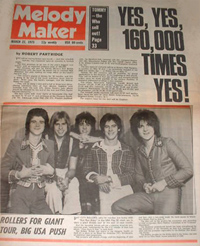
ABRUPT: and Alvin has been a busy man since the abrupt
change in his musical career just under a year ago.
Mention Alvin to fellow musicians, and you’ll get a
stock response; “Good Lord is Alvin STILL playing ‘I’m
Going Home?’ The answer is ‘no’ TYA is behind him,
and Alvin,
Guitarist and Pioneer has replaced Alvin,
Man In A Rut. It was not without opposition that Alvin
took the gamble that led to the end of Ten Years After. He
says, quite honestly , that in the final days, only
money held the old band together, and of course his Management were not to keen on him throwing away what
they may have regarded as a sound investment.
There was doubtless a certain amount of wailing and
gnashing of teeth in the corridors of power, when Alvin
flung in his lot with the likes of Mel Collins, Tim
Hinkley and Ian Wallace, leaving out in the cold Chick Churchill, Ric Lee and Leo Lyons. As the dust settles
still, it is possible to perceive that while TYA are no more, and Alvin has severed some of his ties with Chrysalis,
the guitarist is determined to broaden his horizons, and stay at the forefront of musical
events.
Alvin’s acres are situated in rolling countryside,
not far from George Harrison’s palatial home. The latter is
surrounded by lodge houses and high walls and looks not
unlike one of those mid-Victorian establishments designed to bring 19th century enlightenment
to the insane.
ABODE: But Alvin’s pad has a friendly air of a
gentleman farmers abode. And indeed it was such a place, when
over a thousand acres fell within its domain. So
important was its role in the community, that it served as an
air raid warning station and water rate collection centre, until most of its land and assets were stripped away
and finally a rock and roller from Nottingham took over
where once Squires held sway.
The slight air of decay is heightened by the area of
devastation that was a milking shed and indoor tennis court,
which recently collapsed during a storm. “That’s
what comes of living in big houses,” says Alvin
phlegmatically. But what will future tenants make of the vast recording
studio Lee has built in the Tudor barn, I wondered. Master
Lee may have little inclination towards agriculture,
but he is certainly not idle. He has just returned from the Americas, and a successful tour with his new band
(known
as Alvin Lee & Co), when we met in his lounge and discussed pertinent
matters.
“I got back a week ago and we finished off the tour
in Honolulu. We spent seven weeks on the road and it was very
interesting. First of all we played Europe and
Scandinavia. We played one gig in Paris and just before
Christmas, we played some dates in Germany. “Worried? No not
really. The reaction in Germany told me we were onto the
right thing, although the Scandinavian audiences were a
bit strange. But I think that’s peculiar to Scandinavia.
They’re not so in touch with world musical developments. I got the feeling they didn’t know what to
make of us. That was one place we suffered from not being like Ten
Years After. “In Germany if felt more like we were doing
a show. At first it tended to be just a list of
songs,
y’know? It really came together in Germany, where we played
at some American bases, and that made us feel
optimistic about playing in the States. “I was worried there
would be shouts for ‘I’m Going Home’
but there wasn’t a lot of that. In the first fifteen
minutes we established that this was going to be a different band and audiences seemed
rather stunned. We played mainly 5,000 seaters and a couple of big
ones. The people came to listen and
realised it wasn’t just a rock and roll extravaganza. The
atmosphere was more intimate and controlled, without
people rushing to the front of the stage.”
Did all the guys in the band enjoy the experience?
“Yep. There were eight of us stuck together for seven
weeks, and we’d not worked together before. There were a
couple of gigs that weren’t up to standard, but one thing
I’ve learnt after eight years on the road, is not to get
upset about good and bad gigs, because as long as the general
standard is high, audiences won’t worry.
BUSINESS: “In
fact the audiences were great, and only on the business side,
were some of the promoters worried.
Some people thought it wasn’t Alvin Lee without
TYA---they thought it might be somebody else using the same
name! “We did some places I’d not played before, like Knoxville Tennessee, and it was a good
experience, for the band got better and
better. And what had been
an experiment for me before Christmas, has now become my definite
direction. I wasn’t sure until the tour, but
I really got off on it.
|
I would have done ANYTHING to get out
of the rut. “The vibe I got back was that we were
playing to the people, rather than presenting a hypey,
superstar bit, and a lot of people approved of that. A lot of
silliness goes on in the world of groups, and it came across
that we were taking the music seriously. “
A lot of people
coming to see what we were up to, were turned on by the new
stuff. They liked the percussion duel between Ian
Wallace and our conga player, Brother James, and Mel Collins sax
playing. “One
of the highlights of the trip to the States for me, was a
session I did in Nashville with Earl Scruggs. It’s his 25th anniversary with
Columbia and they called me up to help out on a celebration
album.
|
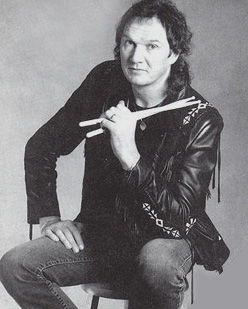
|
FIDDLE: “There was Charlie Daniels the fiddle player
and guitarist and Reggie Young, who it turned out I’d heard on so many
records. I’d always liked his solos
and never knew who played them. He was on Bill Dogget’s
‘Honky Tonk’ and Billy Swan’s new LP.
“Let me see---Tony Joe White came down, and part of
the Marshal Tucker Band. It really was a party. Everybody arrived
very late, and I was all early and businesslike. I asked
Earl Scruggs what he wanted to play and he said: ‘Ah
don’t rightly know!’ “But we did four tracks on one
session, then I went off and did a gig, and came back
for some more sessions, this time with Aretha Franklin’s
keyboard player, and Willie Hall who was the drummer on
the original ‘Shaft.’ He was steaming. “I don’t know
when the album’s coming out or what it’s called,
but Bob Johnstone produced it. We got on so well I wanted to
invite them all round to my place and make an album. We
could call it ‘Nashville On Thames.’
“I also did a Bo Diddley session in New York, with
Leslie West and myself on guitars, and Carmine Appice and Tim Bogert as the rhythm
section. We did all the
old ones like ‘Bo Diddley Is A Gunslinger.’ I just turned
up and blew, and it was great. No, I couldn’t get any of
the tapes I’m afraid! ”
HATE: Alvin admits that launching his new band was like
starting again: “But we started on a good level, headlining at 6,000 seaters and I like
working. Hate
days off. I’d sooner be playing every night. The nice thing was that people accepted us and we didn’t have
to play any old numbers at all. “With TYA they always shouted for the stuff they
knew. The LP we did live
from the Rainbow sold well in America, about 100,000
but it only sold 8,000 in England and I was
disappointed about that. Perhaps if we had done a tour here,
it might have helped. “We’re doing some dates now, not a
major tour, but some universities. I’d sooner do that than
concerts with all the teeny-bops and teddy-boys. We
want to play to a listening audience. We’ll be working until the end of March and then it’ll be pretty
loose. “It’s nice. There’s no pressures. We just blow
and have a good time.”
Will there be another LP from the group? “Well there’s not another release planned until the
Autumn. I want to do some new things and may not stick to the same line-up for
recording. We’ve been leaning
a lot towards jazz, under the influence of Mel and the bass
player.
FREEDOM: “That’s just the way it worked out and it
wasn’t intended. I believe in giving musicians freedom,
although the business element believe I should dominate
and come on strong. I just enjoy being a part of the band.
It’s not really my music, but I’m adapting to their
style. “It’s a very funky rhythm section, which isn’t
exactly my style, but it’s taught me a lot of discipline. Ten
Years After was one long raving solo, but with Mel blowing
away, I and afford to lay back.
“I love his playing and he’s been getting great
reviews.
And Ian’s drumming is so dynamic. He’ll drop the level right down into
another groove, and he’ll do it anytime, so you have to
watch for the signal. A couple of times he’s left me
wailing up there on my own! I’m adapting to it, and it’s
good for me musically. “If Mel solos first and I follow, then
I have to pull my licks together, because he’s
phenomenal. He can play ten times faster than me, and
with such light and shade.”
Has TYA definitely broken up---officially? “It would appear so. I’ve not heard a word from
anybody since last May. But I keep getting bills. It’s a
shame ---it seems to have dwindled to nothing. We were never
a great musical band as such, but it had energy. When the energy faded it left a successful
shell, without
any meat. “I
hear Leo is now managing Wessex Studios, and Ric has got an LP
together, but I’ve not heard
from any of them. Mind you, it had been like that for some
years. We never spoke to each other except during the tours. If you have no mutual interests it’s got to suffer
sooner or later. “Maybe we’ll get back one day, but
the only thing that kept TYA together was money, and that’s
not the right motivation. It had been like that for two years. We had been together for eight
years. We nearly made it to ten.”
|
|
RECORD MIRROR -
March 29, 1975
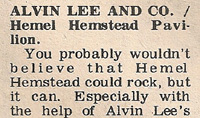
Alvin Lee and Co.
Concert Review
Hemel Hemstead
Pavilion (Sunday Concert)
You probably
wouldn’t believe that Hermel Hemstead could rock, but it
can. Especially with the help of Alvin Lee’s new band
and a mixture of new songs and old rockers. The band, a
six piece blend of old Stone The Crows and King Crimson
members, are individually proficient, but took a long
time to bed in together. So it wasn’t until the later
reaches of the set that things started to move. Having
just returned from America and now filling in time on a
few UK dates before recording their first album, the
band as a whole are warming themselves up, getting to
know each other. They’re well on the way, though not
quite there yet. Though numbers like: “Keep On Moving”,
“Got To Get Back”, “Somebody’s Calling Me”, even
“Freedom For The Stallion”, the quality of the musicians
over came any hint of
un-togerther-ness.
The atmosphere on stage was loose, joking with each
other and generally at ease. Mel Collins sax was
featured heavily, and though he is an outstanding
player, one felt a lot more tracks might have featured
more of Lee’s guitar. When it did appear, so did the old
magic. Sad thing was, it did not appear for any length
of time. By the time of the encore:
“Every Blues
You’ve Ever Heard”, and “Ride My Train”, the audience
had gathered round the stage and were shaking and
dancing where appropriate. Yes, they’re a solid band
alright, just a bit new at the moment, which promises
well for the future.
Article by Martin Thorpe |
|
New
Musical Express 4/ 5/ 75
THERE’S
A WHOLE WORLD OF LICKS OUT THERE:
AS ALVIN LEE becomes musically more itinerant in the grand
tradition of the Disillusioned Rock Star nonchalantly wandering in and out of
projects, it seems his
saga is becoming correspondingly less impressive. Even now, several years after what the hulky AL describes as
“my first move away from neurotic rock” (when
he recorded the album “On The Road To Freedom” with Mylon
Le Fevre between appointments with Ten Years
After) he is considering ceasing operations with the present
band, Alvin Lee & Company. “As far as this band goes
we only plan to work till the end of March, then it’s back
to the studio. Back to the drawing board,” he explains.
You might say Alvin lays it on the line in a sometimes
humorous, often honest, and generally engaging way.
The Most Boring Man In The West must surely be a reference to
his guitar playing, and not his conversation.
And just in case you’ve as much of an aversion to Alvin Lee
Interviews as instalments of Crossroads we’d better fill in a few biographical details to bring you up to
date. 
Musically speaking, Lee was born in the late 60’s and
remained as the head of the Ten Years After household
until 1973 when, due to spiritual disenchantment, he buggered
off with the aforementioned Le Fevre. “It was the first time in four years I was coming out of the studios
overjoyed with something I’d done.” He comments. “And
it gave me the energy of my younger self. I realised I
wasn’t really getting old, I was just getting in that rut,
and if
I got out of it and did things—it’d keep me going.”
Obviously delighted with the experience and excitement he
encountered once out of the traditional confines of a stable
unit, he started to poke the neck of his Gibson 335 into
alien areas. With Boz Burrell, Tim Hinkley, Mel Collins and
Ian Wallace he formed a band called ‘The Gits’ “a funky kinda
thing, not unlike the Average Whites”. When
Boz split for Bad Company they disbanded, making
way for other musicians to enter Lee’s life, such as Alan
Spenner, Neil Hubbard and the Kokomo singers.
Their Rainbow gig was recorded (“In Flight”) and filmed
and marked the conceptual debut of Lee & Company.
Changes ensued: Wallace and Collins stayed but the rest of the
band now consisted of Ronnie Leahy, Steve Thompson, and percussionist Brother James. Earlier this
year they toured comparatively small theatres in America and more recently played British
Universities.
From the States dates Lee came to two distinct conclusions;
because the smaller theatres were “a strange environment” the security forces were totally able to
control the audience and so prevent a suitable ambiance in
the music. In fact, only six of their dates really impressed
him. So next time round he intends to “strike a medium” between the low and high venues. Secondly; the band wasn’t all it should be. “I think where
it felt short—well, in some places it didn’t, it was great
but elsewhere it was just a bit cold, a bit sessiony.” he
remarks. “I get it too. If I’m playing and I turn round on
stage and see everybody getting into the thing, but not
getting off visibly, I’m not suddenly gonna get off and
start leaping around, because I’d feel silly. “If I turn
around and see, like Leo” (Lyons of TYA) “for example
who’d always be thumpin’ an’ thrashin an’ sweatin’…..that
kinda gives me a kick.
“So I wanna go in the direction of keeping the musical taste
I’m getting into, but produce a bit more kick and a
bit more balls. That’s what it needs. In this band I’ve
felt that the climax comes too late and too quick.”
Alvin does not, however, lay the blame totally on his band. He
mentions one problem that he still suffers from;
the reputation of being “a rock ‘n’ roll, boogie-woogie,
rave up-type guitarist”. Consequently audience response comes on what he calls “a trite three chorder”, rather
than on, say the modern jazz which had preceded it. “There
again,” he says, defending his boogie-woogie image, “when
I get out on stage and I feel that vibe I actually want to do it. If the audience wants to get rockin’, I dig
playing like that. “It’s just that this band is almost too
tasty to rock ‘n’ roll with effect. “It’s so tight,”
he elaborates , “that it gets boring quicker than if your
playing with somebody who’s feeling something, and maybe they….uh…over
feel and go off. But you get these new changes and new things
happening. “I’d really like to look
for some fresh musicians.”
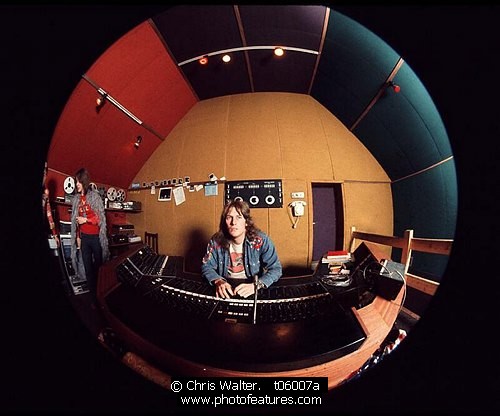
But what is Lee attempting to do with the Company bands? His
attitude to do this particular project seems
ambivalent. It appears he’s attempting to form a unit of
which he could be a mere part, in a similar way to
what Clapton did with the Dominos. Yet he still wants to
remain the front man.
"It really wasn’t meant to be,” he says emphatically,
“but that’s the way it turned out. When you do the singing
and the guitar playing you tend to be the front man rather
than a musician.” And he adds that, at a recent jam session in Dingwalls with Carol Grimes and others, he
particularly enjoyed standing by the speakers just
playing guitar. “I think with the right people I could do
that.” He continues, “Jimmy Page is just a guitarist, but it’s his band, his direction, but he has Robert Plant
dealing with the sexual image and the fronting, which is great, because that’s something which has always made me
feel awkward, ya-know? “I really would like
to be….I already think of myself as a guitarist. I don’t
think of myself as a singer. I just kinda do that
adequately enough. I’m not a phenomenal singer, I don’t
have a voice that’s recognisable like say Rod Stewart.”
Of course, another consideration on this point is that Alvin
Lee controls the purse strings, and so pays the guys
a wage, which immediately creates something of a gulf between
them. (And it’s also feasible that his ego prevents
him from theoretically lowering himself to an equal status
basis within the outfit).
“Unless it is a band of people that I could feel on a par
with musically.” He explains “it couldn’t really be an
equal
situation, because as I say, if I go and do a tour at the
moment as Alvin Lee & Company, people come see me and
what the Company is. It’s not as if the Company itself is
drawing people in. “It could do, if I continued to work it,
but I’m not going to get a band together and stick with it
because that would become the same kind of trap as Ten
Years After got into—and probably a lot quicker, because
I’ve been through that scene.
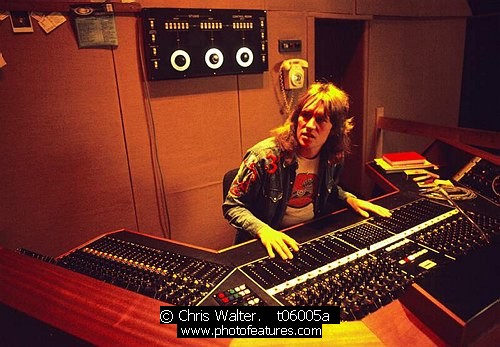
“I enjoyed it,” he hastily asserts, “but all the bands
that stay together a long while seem to go in that direction.
It
turns into A Job. Tours turn into a “How much do we get?”
That’s the wrong motivation for going out to play
music, just to make a few bucks. “I’m not against making
bread, but I’d rather get something I’m proud to be
with and then work out how to get some bread out of it. That
seems more like the right way of going about it.”
ALTHOUGH Lee will retain those musicians from the present band
“who’re really keen” he now intends to find
some fresh faces on the English scene, and move into various
musical styles, which may be reggae, blues or even
jazz. Whatever turns him on. “What I intend to do is try
different things out,” he says. “I’m looking for
different musicians with different influences, ‘cause what I’ve
found is, different musicians around me with different influences
make me look for new styles. “Besides, I think there are
good musicians in England. But the scene
has
got so poppy again. It’s gone round in a circle. There’s a
lot of good musicians who resort to playing
something
really corny just to get something going.” He should know.
“A lot of bands that you see backing up
singers
and duets on TV have got good musicians. It’s just that
they’re stuck in a rut. “Everything’s an experiment.
I don’t really feel anything that strongly urging to come
out…except to try new directions. That’s
the
only real urge. “The most commercial thing for me to do
would be to get a four-piece rock band.” He points
out.
“I mean, the most commercial thing for me to HAVE DONE when
the TYA thing was DROOPING
would’ve
been to get three more musicians, keep the name, and go out
and rock ‘n’ roll. “But, as I say, my own
head heeded to go in these other directions. “I don’t want
to go out on the road for the sake of doing it, I
want
to have something going to take out and show the people. Which
is what I’ve done with Company. “It’s
been successful.”
WITH
ALVIN spieling so candidly it’d be remiss not to bring up
the subject of TYA---remember. Of course what
it’s
not in vogue these days to announce the fact when a major band
splits up. So, like the Moody Blues, TYA
is
“inactive”---only because nobody will say, Yes folks,
we’ve split. Which of course, is something of an
advantage
to us, because---if ever the situation did occur---we won’t
have to suffer an exhaustive campaign announcing
a reformation. “It’s DEFINITELY FINISHED.” Says Lee,
“because no one will say it’s finished.
But
as yet I don’t see any move to get it together. The only
reason they or I would consider it boils down to
the
money again. “I’m sure everybody’d ring up and say,
‘Let’s do a tour and make a few thousand’, but nobody’s
saying ‘I really want to play’.”
Alvin
considers the high point of TYA was when they played the
Marquee. “We Kicked Shit. Sweat and grind.”
he recalls, “I really used to get emotions in those days.” Even
so he is reluctant to deride their music towards the end, and
explains numbers such as “Goin Home” were
musically
good---“because we’d played them 8,000 times.” But their
career followed the pattern of so many
successful bands. Once they had financial stability their interest
diversified, and touring became a monotonous process.
Their motto, Lee remembers, was “Get on, get off, and go
home.” And for the last two years it was a
thoughtless process. “I could be up there playing what appeared to be an
incredible solo to the majority of
people.”
says Alvin, “but in fact I was probably thinking about
something else.” Like?
 “Looking round the audience and
seeing who’s there and things. Checking out that scene,”
he smirks, “was always one of the sidelines.
Sometimes
I’d just wander off totally. “It’s like when you’re
driving a car, you’ll be thinking about something else,
and then suddenly you’ll come back to driving, and you
realise you’ve just driven through London, down
the
M4 and turned off, but you don’t remember a thing about it.
“Well when you repeat yourself playing the same numbers
you just play on automatic.”
And
the analogy he uses to explain exactly why he is now
experimenting in music is as equally, er, illuminating.
“It’s
like an old tired marriage a lot of the time. Nothing gets you
off more than a bit of fresh on the side. That’s really
the basis of what I’m doing---just looking for that fresh
excitement. Trying to renew the energy I had before.
“It’s working. “As long as it’s good it can go in any
direction,
from blues, jazz. Rock, reggae, classical, musique concrete,
to whatever. My gig is to make it good, and enjoy doing it.
“There’s a whole new World of licks and
tricks
to experiment in.” “Looking round the audience and
seeing who’s there and things. Checking out that scene,”
he smirks, “was always one of the sidelines.
Sometimes
I’d just wander off totally. “It’s like when you’re
driving a car, you’ll be thinking about something else,
and then suddenly you’ll come back to driving, and you
realise you’ve just driven through London, down
the
M4 and turned off, but you don’t remember a thing about it.
“Well when you repeat yourself playing the same numbers
you just play on automatic.”
And
the analogy he uses to explain exactly why he is now
experimenting in music is as equally, er, illuminating.
“It’s
like an old tired marriage a lot of the time. Nothing gets you
off more than a bit of fresh on the side. That’s really
the basis of what I’m doing---just looking for that fresh
excitement. Trying to renew the energy I had before.
“It’s working. “As long as it’s good it can go in any
direction,
from blues, jazz. Rock, reggae, classical, musique concrete,
to whatever. My gig is to make it good, and enjoy doing it.
“There’s a whole new World of licks and
tricks
to experiment in.”
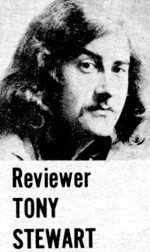
Article
written by
TONY
STEWART
|
|
From Rolling Stone Magazine 4/ 10/ 75
Alvin
Lee - "In Flight" (Columbia PG 33187
)
British
blues has always been a workmanlike form, as much a job as
a pleasure. Alvin Lee is smart enough to
realize this, and having deserted his own limey blues band, Ten
Years After, he has made In Flight in pursuit
of a new image. Unfortunately, Lee’s problem isn’t
easily wished away. He sinks into new restrictions
quicker
than he can soar away from the old ones.
Ten
Years After was never much of a group, although they made
some interesting records, particularly
Ssssh
and Watt. The group was the sleeper surprise of Woodstock,
and “Good Morning Little Schoolgirl”
and
“I’m Going Home” were significant pre-heavy metal
tours de farce for guitar.
All
of their exciting moments, though, had as much to do with
stagecraft as music. Lee’s flashing smile was as
important
as the white heat of his guitar runs. Alvin Lee was fast,
the epitome of the British speed demon
guitarist,
but his speed and his smile were intertwined forever.
The
one made him saleable, the other made him identifiable; I
was never sure which was which, but we
all
know what too much speed does for the teeth. Still,
without those alabaster incisors, Ten Years After
might
have lent new meaning to the concept of facelessness which
dominates so much of the rest of British blues.
For
all its limits, Lee’s twin talents gave them a head
start over the various Foghats, Savoy Browns and Mayalls. Lee
has personally, if not charisma, and the sense of
humour--not just fun, which is intimately tied to work—
that
ought to go with it. It is difficult
to imagine even such an inspired British bluesman
as Eric Clapton
having
the ironic self-perspective to tote a watermelon over his
shoulder as he trudged off the Woodstock stage,
in full view of 500,000 fans and half as many cameras.
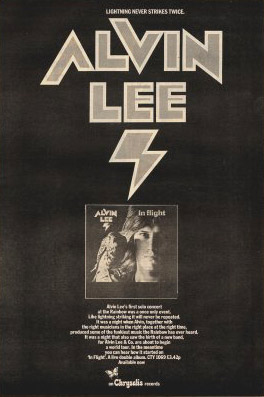
Lee
is in flight, in deed as well as concept, on his new album.
Fleeing that confining image, however, he seems
desperate,
uncertain of just what he’ll choose to replace it with.
Consequently, In Flight is a kitchen-sink job;
a
live album, two records, with horns and a female chorus.
The music can’t decide between rock and blues
and
half-assed mellow jazz. There isn’t a chance for any of
the facets to shine long enough to give the record,
or
Alvin focus.
Lee’s
best moves are as a rock & roller, even if his most
coherent ones are still tied to his version of the blues.
The
most interesting track on the album, “Mystery Train,”
fails utterly. After Elvis Presley’s and Junior
Parker’s
versions,
“Mystery Train” wasn’t a song anymore at all; it was
a pair of records, each defining the limits of one
of
its dual themes (sex and death). Lee has nothing to add to
that except a pleasant, smoky voice. But even
that
voice is obscured by the awful chorus. The English have
been trying for a decade to figure out what to do
with
the Stax concept—the way voices and horns are used in
Memphis—without much luck. Lee’s ideas
aren’t
much more useful than Joe Cocker’s. The chorus
shouldn’t drown out the singer in an
arrangement
like this; it should add tension. Here the chorus
elasticises everything, drawing it out to the point
of boredom. It happens time and again—on “Slow Down,”
“Money Honey,” which had the chance to be special,
even
Lee’s own best song “I’m Writing You A Letter.”
Surprisingly,
Mel Collins’s sax and flute are handled with some taste,
probably because they are not, as with most
blues
groups which resort to horns, bowled over by a blaring
brass section. (I know of no great white rock record
in
which brass plays a dominant role.) But for all their
limitations, the rock songs are still more effective than
Lee’s blues, which for the most part are just as excessive in
length and
velocity as those he played with
Ten
Years After. Only sax dipping in and out reminds that this
is not a TYA record.
With
his usual irony, though, Lee redeems himself a little,
simply by calling one of the songs “Every Blues You’ve
Ever Heard.” He ought to be required to open his show
with it as a sort of caveat emptor –and not he alone, but
the whole sorry batch of Anglo blues mummies. Still,
this isn’t as inauspicious a debut as I may have made it
seem. Lee has broken free of the TYA image,
certifying
himself as a rock singer of some talent. The rockabilly
cuts here move, and if it weren’t for the chorus,
you
could say they never get cute, as too much British
pseudo-rockabilly does.

With
a little reorganization, Lee might have a fine post-heavy
band in the making.
by Dave Marsh, music critic for ‘Newsday’
|
|
Record News: Alvin
Lee’s new album “Let The Sea Burn Down” will be
issued in mid – September by Chrysalis. Among musicians
featured on the set are Ian Wallace, Tom Bryson and Ron
Burgh (all on drums) Andy Pyle, Colin Gibson and Boz
Burrell (all on bass); Tim Hinckley (keyboards), Harold
Burgon (Synthesiser) and Jack Lancaster (sax). The set was
recorded this spring at Lee’s home in Oxfordshire.
(1975)
|
|
THE STORY OF POP – SPECIAL VOLUME – PART 43 – 30p – EVERY
THURSDAY:
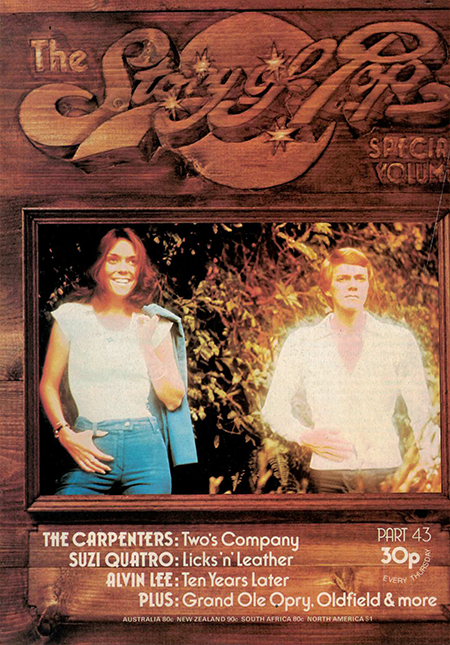
THE GREATS – ALVIN LEE: THE AXE
MAN COMETH: 1974 / 1975

If Eric Clapton Was The First
Guitar Hero. Jimi Hendrix The Most Absolutely Crazed, Then Alvin Lee, A Guy Who Looked As
If He Came From Scandinavia, But Really Hailed From Nottingham, A Centre of
England’s Light Engineering Industry, Was The Fastest and
In Terms of Personality The Sanest. Not For Alvin Was
There Any Heavy Involvement With Dope Or Religion. If He
Experienced Any Intense Personal Pain Then It Never Showed
In His Playing. Unlike Eric Clapton, Jimi Hendrix or Peter
Green His Playing Never Sounded Totally Committed To The
Blues, Though That Was Where The Bulk of His Inspiration
Came From. Nevertheless, Alvin Lee’s Status As A Bona-Fide
Guitar-Hero Was Established By The Late 1960’s (August 1969)
Following In The Wake of Eric Clapton and Jimi Hendrix and
In A Way, It All Happened In An 11 – Minute Period At
Woodstock, The Rock Festival That Was For A Time Regarded
As A Turning Point For A New Generation. It Was There That
Alvin Lee and His Band, Ten Years After (Alvin Often
Maintained That "Ten Years After" Operated As A Co-Op, But
As Time Went On It Became More and More Evident That Alvin
Lee Was Ten Years After; As He Wrote All The Songs, Sang
Them, Played Almost All The Solos and Was The One That
Audiences Focused Their Attention On) – Turned In A
Rip-Roaring Piece of Rock – Blues, Short On Aesthetic
Value, But High On Sheer Flash, That Highlighted Some of
The Fastest Electric Blues Inspired Guitar Ever Played, On
The Band’s Song "I’m Going Home."
Alvin’s Appearance
Became One of The Highlights of The Subsequent Woodstock
Movie, This Is Where Alvin and The Rest of "Ten Years
After" Won Their Place In The Hearts of Countless American
Rock Fans For Their Particular Brand of Boogie. As
American Rock Fans Are Particularly Partial To Boogie and
Alvin and His Group Could Boogie Better Than Most. Hence
The Reason That They Did 28 Tours of The United States Up
To Their Farewell Tour In Mid 1975.
The Roots of Ten Years After
Grew From A Nottingham – Based Band Called "The Jaybirds"
That Was Formed In The Early 1960’s – The Personal At That
Time Included Alvin Lee and Leo Lyons. The Band’s Roadie
Was Chick Churchill Who, Though He Wanted To Be, and Was
Considered By The Others To Be Good Enough To Join The
Outfit, He Didn’t Have The Money To Buy A Hammond Organ,
The Instrument That He Had Been Playing, Courtesy of
Friends, For Some Time. It Was The Hard Round of Gigs That
Enabled The Jaybirds To Save Enough Money That Enabled
Them To Place A Deposit On A Hammond, and Chick Was In.
This Is When Alvin Lee Decided
To Change The Name of The Band To "Ten Years After" Meaning: "On The Grounds That
"We Started Ten Years After Elvis Presley."
If Ten Years After Had Appeared
On The Music Scene A Year Or Two Earlier, Alvin Lee
Wouldn’t Have Been Allowed / Accepted, or Given So Much
Room To Stretch Out As The Instrumentalist He Was On The
Debut Ten Years After Album – (1967).
It Was Eric Clapton and Jimi
Hendrix That Opened The Doors and The Record – Buying
Public Were Ready To Hear As Much Blues Inspired Guitar
Playing As Could Be Laid On Them. So Alvin Obliged Them On
That Debut Album and Gave The Ever-Increasing White Blues
Audience Just What They Wanted.

RARE SPEED:
Veteran Bluesman Willie Dixon’s
"Spoonful" Was Was Somewhat Daringly Included On The
Album; After All, Cream Had Turned In Their Version of The
Song On Their First Album, Called "Fresh Cream" That Was
Released In 1966. While Ten Years After’s Version Showed
That Their Guitarist Was More Than Just A Competent White
Contemporary Blues Guitarist. And While Alvin Didn’t Come
Across As Sincere As Eric Clapton, Or Peter Green, His
Playing Displayed A Rare Speed If Not Thoughtful
Construction. On Some of The Album’s Cuts This Showed To
The Extent Where Alvin’s Playing Wasn’t So Much Fast As It
Was Downright Hurried For Instance – "I Want To Know" - On
Al Kooper’s Blues "I Can’t Keep From Crying Sometimes,"
Alvin’s Playing Was Jazzier Than The Work of Other Popular
Guitarist of The Era…And It Was This Side of Alvin’s
Playing That Was Fully Explored On Ten Years After’s Second Album,
Called "Undead" – A Live Recording!
During This Time Period Ten
Years After As A Group Very Much Differed From Their
Contemporaries In Their Light Approach. Their Rhythm
Section of Leo Lyons and Drummer Ric Lee, Didn’t Make Any
Attempt At Being Heavy, Preferring to Go For An Approach
That Had Much More To Do With Swing. Alvin’s Playing
Lacked The Knife-Edge Tension of His Contemporaries and He
Preferred To Stretch Out With His Guitar, Like On The
Album’s "I May Be Wrong But I Won’t Be
Wrong Always" Which Again Demonstrated Alvin’s Great Speed
Playing. Unfortunately, He Tended To Repeat His Licks
Incessantly So That His Playing Came Across As Being
Unimaginative, Even If It Did Rate High On Flash!
Undead Also Contains The First
Ten Years After’s Version of "Goin’ Home" (It Was Later To
Appear On The Woodstock Sound-Track Album and On Their
"Recorded Live Album That Was Released In 1973). The
"Undead" Version Isn’t As Blatantly Ear-Catching As The
Woodstock Version, and Once Again The Above Criticisms
Could Be Applied To Alvin Lee’s Playing On It. Despite
Alvin’s Aesthetic Shortcomings He Was Beginning To
Establish Himself As Something of a Leading Guitar Stylist
In The Rock-Blues Field, Though A Lot of The Rock Audience
Thought Alvin’s Playing Was A Watered Down Version of The
Real Thing Currently Being Exhibited By Eric Clapton,
Peter Green and Jeff Beck.

ARTISTIC DILEMMA:
Alvin Lee’s Popularity Had A Lot
To Do With His On Stage Antics. With Something of A Stud
Persona, Alvin Had All The Arrogance It Needed For Him To
Become A Guitar Hero, Vividly Contorting His Face While
Seeming To Produce His High Speed Runs Effortlessly.
Ten Years After’s Third Album
Called "Stonedhenge" (Note The Hip Crassness of The Title)
Saw The Group and Alvin Lee In
An Artistic Dilemma. As They’d Openly Admitted Their
Dissatisfaction With Their First Album, (Their Only Studio
Album At That Stage), Stating Candidly That Work In The
Recording Studio Came So Much Harder Than On Stage.
"Stonedhenge" Was A Dire Album,
With Alvin Keeping Himself Surprisingly Enough, A Very Low
Key Profile. What There Was of His Playing Was Restrained,
Only On "No Title" An Early Indication of Just How
Embarrassing Alvin’s Lyrics Could Be, Did His Guitar
Playing Come To The Fore. Again, It Was Short On Aesthetic
Value, But Rock Has Never Been Renowned For Its Good
Taste, and Alvin Lee’s Playing On The Cut, Was Heavily
Distorted and Very Fast, and That Impressed A Lot of
People.
Their Subsequent "Ssssh" Album
Saw Ten Years After and Alvin Lee Finding Their Recording
Studio Feet. This Time The Cover Art Showed Who Was Ten
Years After’s Main Man, As The Album Cover Was
Entirely of Faces By Alvin Lee. On "Ssssh" Alvin Blatantly
Copied Eric Clapton’s "Woman Tone" Technique, Thus
Producing A blurred Fuzzy Effect.
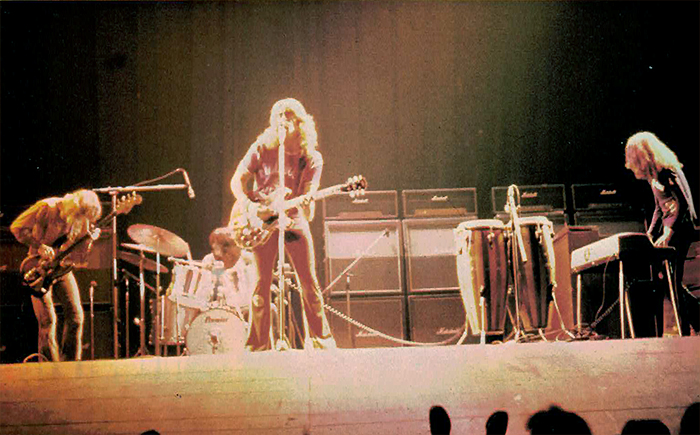
The Band Had Become A Lot
Heavier and So Had Alvin, Tightening Up His Playing Style
Considerably. His Adaptation of "Good Morning Little
School Girl" More Than Anything Else On The Record Shows
Alvin’s Adaptation of The Eric Clapton Mode of Playing,
Although It Lacked Eric’s Finesse. The Style Alvin First
Demonstrated On "Ssssh" Found Its Way Onto The Next Two
Ten Years After Albums, "Cricklewood Green" and "Watt" and
The Group Had By This Time Maintained Full Momentum
Spending Spending Much of Their Time On Vast Money –
Earning United States Tours. Ten Years After Were Going
From Strength To Strength, Even Making The British Singles
Chart With One of Alvin’s Better Songs, Called "Love Like
A Man".
By The 1970’s The Blues-Boom Had
Burnt Itself Out, and For The First Time Ten Years After
Had Very Little To Do With White Blues Rock, Concentrating
On Songs In Acoustic Settings. Alvin Himself Had Improved
As A Guitarist and For The First Time In His Career Showed
A Modicum of Taste In His Playing. A Track Called, "Hard
Monkeys" Shows Alvin’s Playing With More Ferocity Than
Ever Before and Managing To Couple This Added OOMPH With A
Slicker Tone. His Guitar Style Improved Further On Ten
Years After’s 1974 "Positive Vibrations" Album
Which It Was Rumoured At The Time, Could / Would Be The
Band’s Last Studio Album. As Alvin Lee By This Time Had
Established Himself In A Palatial Country Manor House.
Including A Recording Studio Located In One of The Many
Out Buildings On The Vast Property, and Called "Space
Studio" – Recorded Here Was Alvin’s First Solo Album, "On
The Road To Freedom" In 1973. With Mylon LeFevre, A
Musician With Strong Leanings Towards Country / Gospel
Music. The Album Also Included Material From George
Harrison and Ron Wood. ("Woody") Both of Whom Played On
The Album. The Title Track Again Portrays Alvin Lee As A
Very Fine Rock Guitarist, Slick, Sharp and Precise Without
A Trace of His Former Self-Indulgence.
Copyright: 1973 / 1974 / 1975 –
From Phoebus Publishing Company (PBC Publishing LTD).
169 Wardour Street, London
W1A2JX – Made And Printed In Great Britain By Petty and
Sons LTD. Leeds…And Ten Years After Elvis Came Alvin Lee,
The Demonic Wizard of Blues – Rock With A Lightning –
Swift Guitar Technique.
|
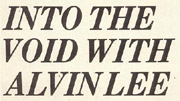
By – Steve Peacock
|
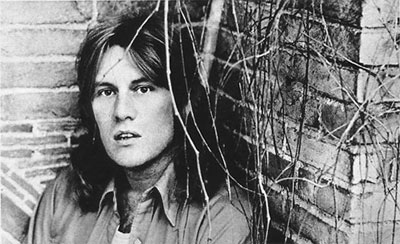 |
From Sounds – April 5, 1975
You’re looking at a free man who hopes to create
Nashville – on – Thames. He doesn’t know what the future
will bring, but he’d like a hit single.
Article:
Show me Alvin Lee and I’ll show you a man who has discovered
indecision as a positive way of life. He’s slipped the leash
on the band that made him rich and famous and he’s allowing
Plan B—Alvin Lee & Co.—to dismember itself with the minimum
of formality. “It was like the evolution of Ten Years After
over eight years taking place in three months”, he says.
Which is not to say that AL&C became hollow product—merely
that it ran as far in its chosen direction as Alvin Lee
wanted it to run with him on board. “This band really got
into jazz as a natural kind of leaning,” he says. That was
fine, he didn’t want to mould them any more than the main
songwriter, singer, front man, soloist and provider
inevitably shapes a band. But the way the band was
developing wasn’t the way Alvin Lee wanted to make music
further than the end of this month. “It’s great, but that
attitude of jazz seems to be “well, there’s an audience
there but don’t let it affect you too much.” If there’s an
audience there, I’m always very much aware of the fact. I
want to deliver something to them that’ll get ém off. That
doesn’t seem to be the attitude of jazz—jazz is
introvert,
and if this band were to continue it’d develop more towards
that and it isn’t really what I want to do.”
Quite what he does want to do is not so clear—not in
terms of style or specific musicians anyway. “There are
options: there’s country, there’s rock…I’ve got a strong
leaning towards getting back into R&B, getting back towards
the old stuff, perhaps leaning towards the blues a bit.
Chunky…chunky funky. I’m going to experiment. I’ve a strong
feeling that I could go any way from now. I’m getting off on
all the styles there are. Maybe the next album will be a
couple of tracks with this band, a couple of something else,
a couple…but I don’t know if it’s the right approach. That’s
the thing. It’d be fun, but…” The right approach can only be
what he fancies doing at the time –yes? “But it is nice to
be able to go out on the road with the same band that made
the album, so you don’t have to get people copying things
that other did on the album. “That’s what nearly happened
with this band but luckily they were strong enough to put
their own personally onto it, and anyway we only did half
the album on stage. But whatever happens next, it’ll grow
out of the next album I do—I now accept that changes take
place, and I’m now inviting them.
“I’ve got a strong leaning to get more into recording and
producing, but I know that after a few months I’d start
getting itchy feet again. I’ve been touring since I was 16
and you get something that builds up inside you that you’ve
got to release, and that you can’t release any other way.
And I’m addicted to America—I have to get out there at least
once a year just to get the buzz from that.” 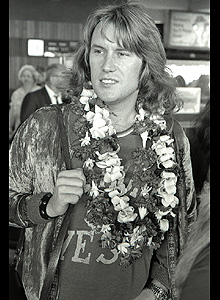
Ah—the roar of the greasepaint and the smell of the Holiday
Inn. Alvin Lee may have the comforts of home and a
remarkably well equipped studio in his backyard, but you’ll
still find his butt shakin´ and his guitar wailing in
Knoxville, Tennessee—even Hemel Hempstead, Hertfordshire.
When he struck out on his own with the And Company project,
Alvin Lee was more or less starting again: it was hardly a
balls-on-the-rail venture, to the extent that he had money,
he could afford a good band and his TYA-made name guaranteed
him a certain amount of built in audience appeal. Yet it was
still quite a bold venture when you consider that he could
have spent the time in his studio or sun soaking in the
Bahamas or Hawaii, grinding out a swift TYA tour and album
each year to keep the accountant smiling.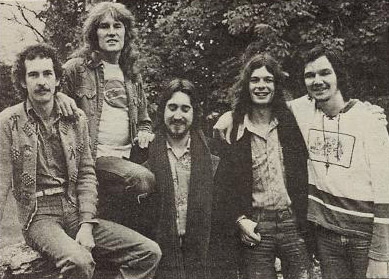
With the original team of Boz, Tim Hinkley, Ian Wallace and
Mel Collins he had the makings of a rock band with enough
drive to satisfy his baser instincts, and enough funk to
make it a dramatic change from TYA: Boz split to Bad Company
before that could ever face the crowds, and the band that
played the Rainbow concert (from which the live album was
recorded) was rather hastily assembled. Neil Hubbard and
Alan Spencer and the Kokomo singers were recruited 10 days
before the gig, but returned to base before AL&C went on
tour.
With the touring band as it turned out—the basic
Lee/Collins/Wallace nucleus plus Steve Thomson and Ronnie
Leahy from Stone The Crows and percussionist Brother James—the
idea moved yet another stage away from its origins. It
worked and Lee enjoyed himself—the music and the situation.
“America was so different it was almost like going for the
first time. What was really good was coming off stage and
talking about music and listening to the tapes…having a bit
of a jam. It was a different relationship with the band, a
lot more like lads on the road—less professional but more
fun. There were a lot more downs as well as the ups—we’d
have incredible long dissections of things that went wrong,
have a sound check the next day and sort it out. With Ten
Years After we used to sleep in the afternoon, get a call at
six or seven, get to the gig at 8:30, tune up and play.” In
a way, the whole process had been a kind of exorcism for the
man who felt himself lumbered with the flying fingers image.
He was able to lie back as a musician and see the
possibilities, but perhaps he over reacted against his
history. “During the tour I managed to conquer the feeling
of wanting to do something loud and raucous but not doing it
on principle. I finally did it, got into some of those
tasteless things I was wanting to do, and the fact of not
doing from the beginning made it all the more effective. It
was really nice and gradual the way it should be.”
Having shown bell book and candle of laid back funk to the
heavy metallurgist that lurks within him, he feels confident
enough to let him out for a trot every now and then.
It was something he had to go through. But with the European
and American tours, he feels this band has run its course
and he is ready for something new. “If this band really
wanted to stay together and had a clear idea of what they
wanted to do, then I’d do it, but first I need to look
around a bit, get some new inspiration and write some new
songs.” In any case it seems unlikely this band will survive
as it is (Mel Collins is pretty certain to rejoin Kokomo),
though it seems equally likely that Ian Wallace will stay
close to Alvin Lee: “He’s got to be the best drummer in
Britain”.
While in America he managed time off to do some sessions:
one in Los Angeles for Bo Diddley, and several nights in
Nashville on sessions for the 25th anniversary album for
Earl Scruggs, alongside people like Charlie Daniels, Willie
Hall, Don Nix—the crew. Among his plans is to: ship Charlie
Daniels band over to his studio this year for a
Nashville-On-Thames sessions.
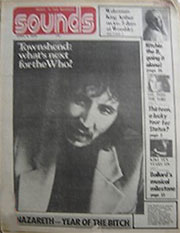
He’s also going to be working on a film—a kind of “up to
date Fantasia based on the idea of Atlantis”—for which he
will provide the music and be involved with mapping our
sequences. That’s in its infancy at the moment.
And there’s another thing: “I must admit I’ve been toying
with the idea of taking the easy short cut with the old hit
single. I know I’ve been against it all my life, but the
Average White Band have proved it can be done with something
that’s just good music. I’ve thought about playing around
with different styles of things, seeing if any of them pick
up.” That should lay the TYA great coat ghosts for good.
Meanwhile, it’s a case of finishing the current tour,
getting out and listening to some music, writing some songs,
and getting some musicians together to play. “I’m going to
get on playing music and see where that takes me.”
|

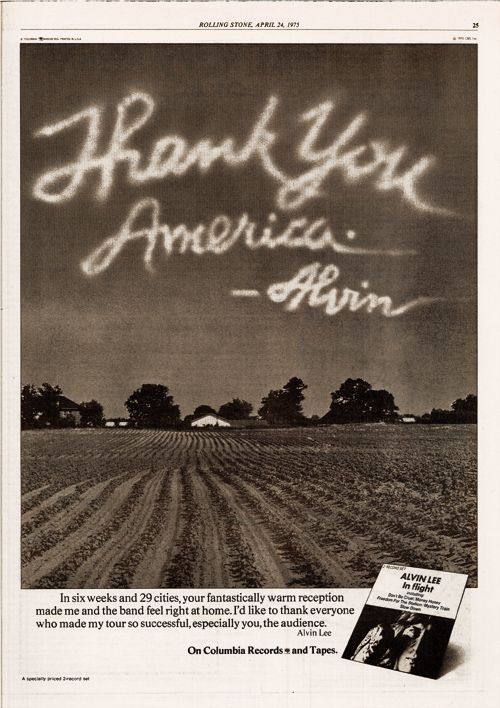
|
May 17, 1975
Antenne 2 (today
France 2, French National TV)
TV show Juke-Box
presented by Freddy Hausser
They visit Alvin Lee in
his studio. The 40 minute program
includes an interview, Alvin
playing acoustic guitar, singing
parts of new songs
as well as Time
And Space, playing guitar along Ride My Train
They show footage from the
Rainbow concert,
playing an alternative version
of Going Through The Door
a track from the group FBI,
also Alvin jamming with FBI
|
May 1975 - BEAT INSTRUMENTAL Magazine,
England
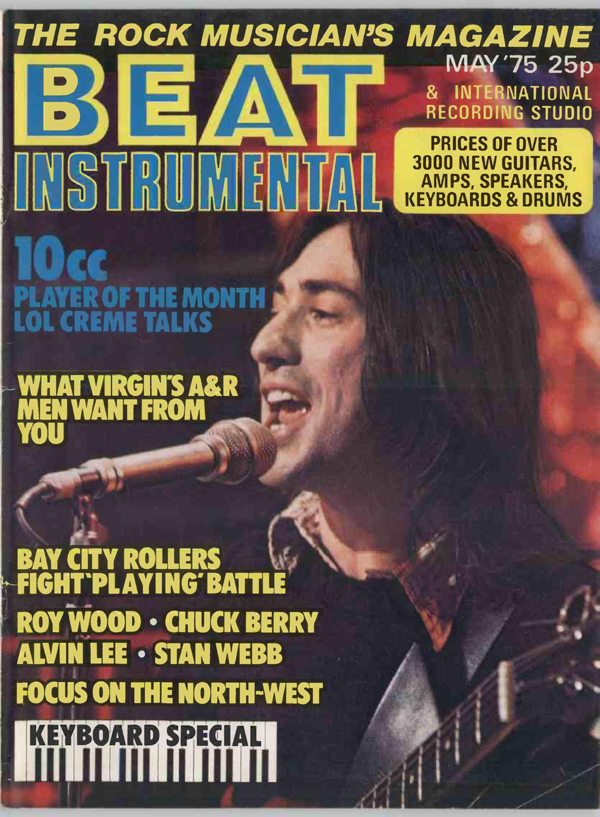
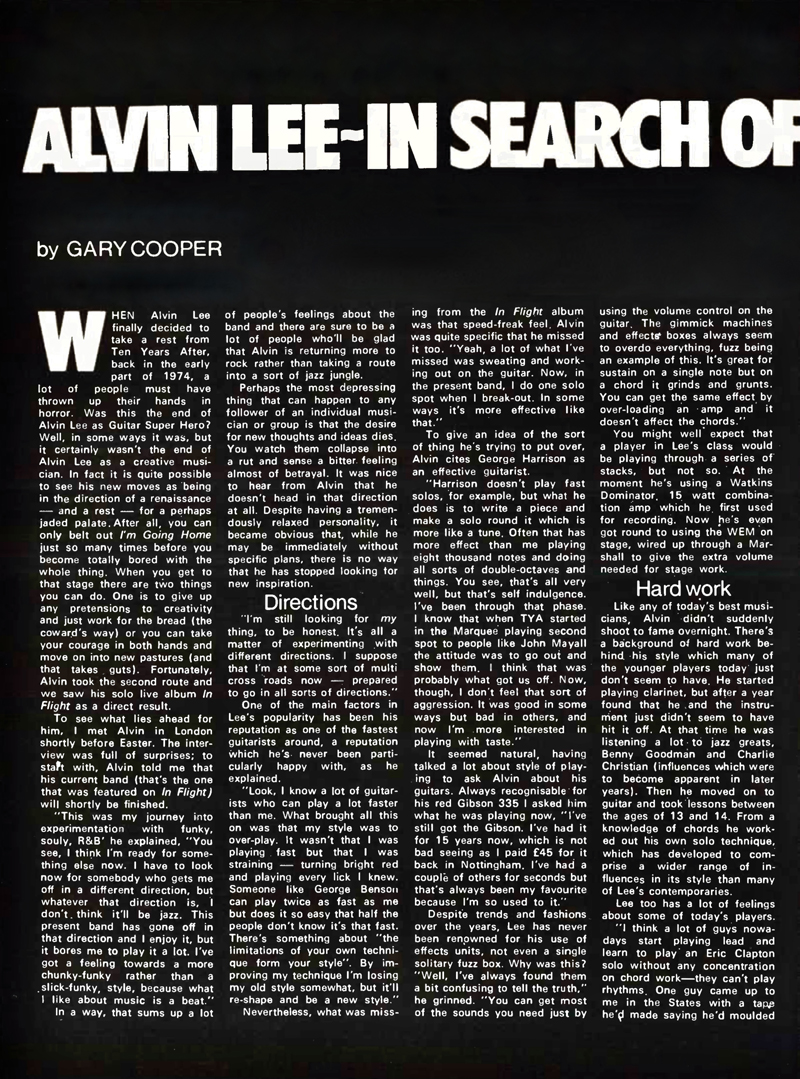
page 12

page 13
|
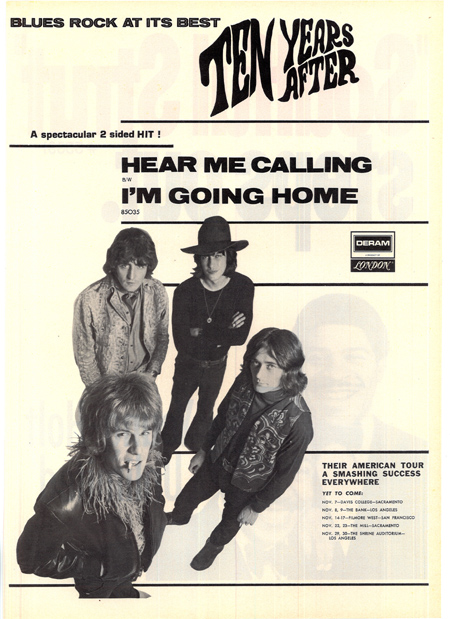
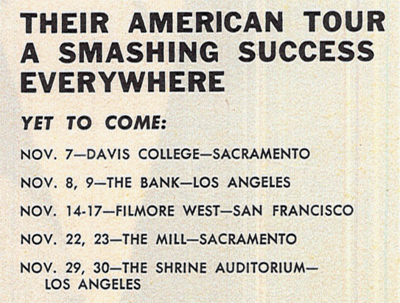
24 May 1975, Melody
Maker
Ten
Years After - “Goin’ Home!” (Chrysalis)
A
compilation album of the first three years of Ten Years
After’s existence. And a pretty neat selection of
some of their best-known numbers, including, as the title
suggests, the TYA classic “I’m Going Home”
a
live version from the Woodstock film.
Alvin
Lee has taken a bashing from some critics over his
“speed-trip playing,” but he and TYA were undoubtedly
worthy
of the success that came their way in the late sixties and
early seventies. Lee became one of the
legendary
guitar heroes and I always thought his playing could be
tasteful at times as well as brash and violent
as it is usually regarded. In
judging Lee the critics often missed the point.
The
band were exciting to watch and it was this excitement,
through flash playing that Lee tried to convey on record, especially on the “Undead”
album, which was
recorded live, and “Ssssh.”
On
this album we have: “Hear Me Calling,” “Going To Try,”
“Love Like A Man,” “No Title,” “I Woke Up This
Morning,”
“Woodchoppers
Ball,” and “ I’m Going Home.”
“Love
Like A Man” is the studio version and it is debatable
whether the live number should have been included,
although
the studio one is much more polished and precise.
“I
Woke Up This Morning” is an object lesson in what can be
achieved without straying far from the basic
blues theme. Lee’s
playing is beautiful, with the rest of the band filling
out the bottom. “Going Home,”
the closer, sums up
the
essential TYA in a nutshell. You can almost see Lee
onstage snarling out the vocals and ripping into
his axe, no quarter asked or given with the excitement rising
as the audience lets its hair down.
But
one of my favourites is “Hear Me Calling,” with Leo
Lyons’ bass thudding out the riff and Lee soloing in a
restrained fashion. An
excellent album showcasing all that Ten Years After had to
offer---and that was a hell of a lot.
By E.M.


This album represents the first three years in the life of
Ten Years After from their beginning playing small British
clubs, to the peak of their world wide acclaim at the
legendary Woodstock Festival, and with it's distinguished
fragment of rock history.

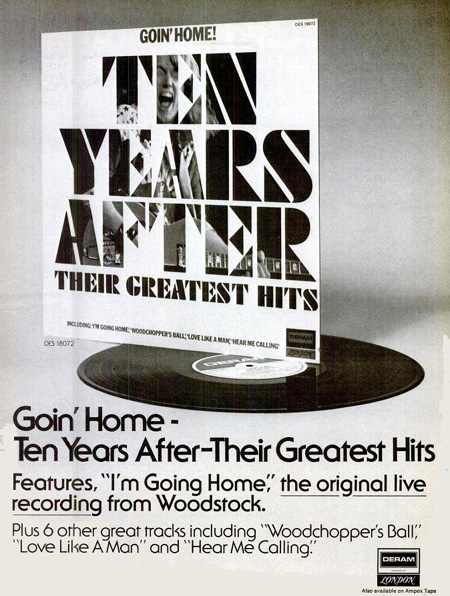
|
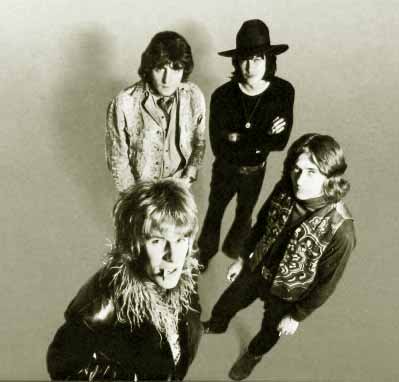

25 May 1975
- CIAO2001, No. 20
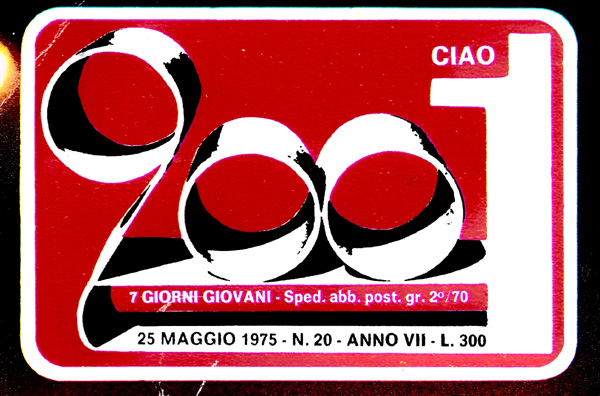
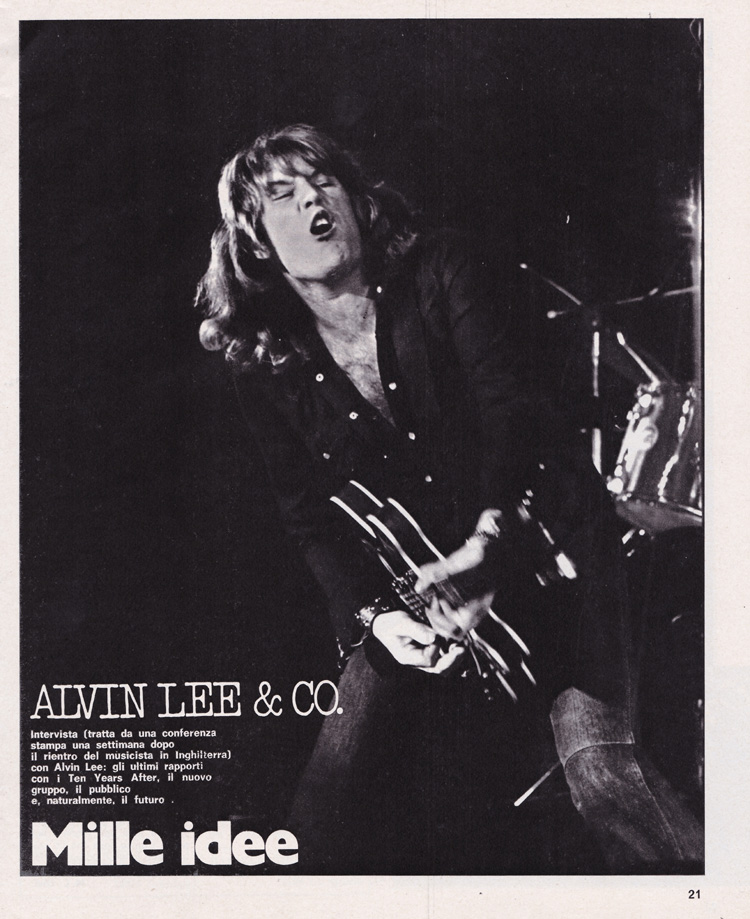
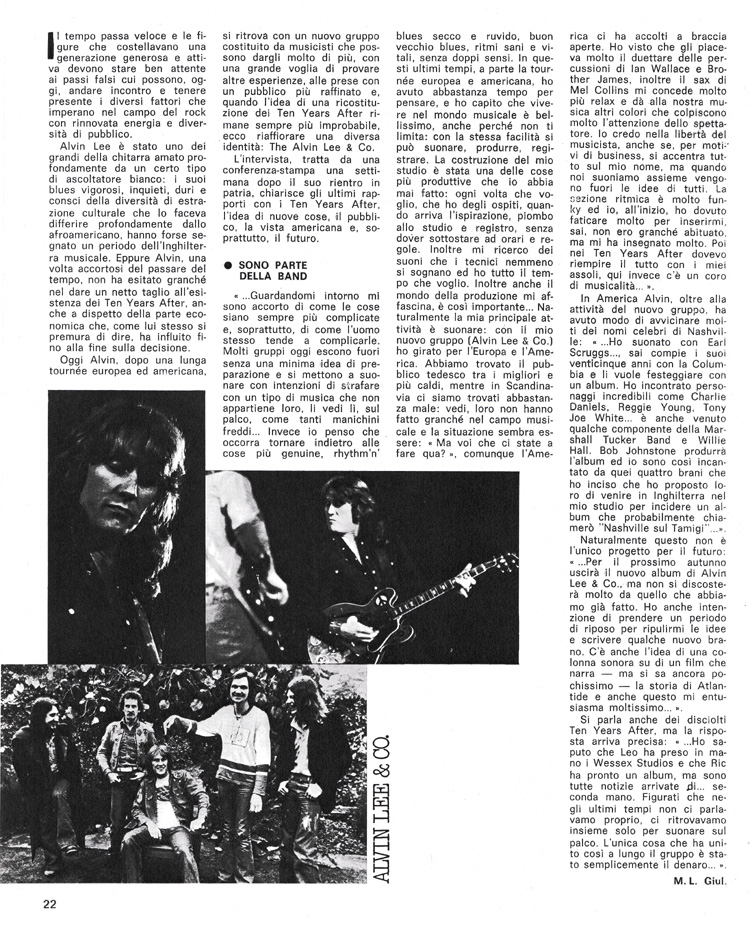
|
June 1975 - Let It Rock Magazine
The world's fastest guitarist takes up his generator,
JBL's and bits in between...
and chooses ten discs to keep
him company
"My Top Ten" from Alvin
Lee:
- “Baby Let’s
Play House” – Elvis Presley: Because there’s a great bit
with Bill Black playing bass that goes…docka-docka-docka-docka.
- “Sweet Little
Rock and Roller” – Chuck Berry. This is possibly my
favourite of his songs. There are a few others I would
include, but I would want to listen to them all again
first.
- "Brother Jack
McDuff with George Benson". It’s done in a roadside club.
It’s really live, sweat dripping down the walls, kind of
feeling; glasses chinking in the background. They blow a
storm…Good musicians atmosphere. He’s probably playing
his best. Put him on stage at the Albert Hall and he
will play well, but won’t have that down to earth
funkiness / looseness.
- "Abbey Road" –
The Beatles: The melodic-ness of it. The fact that their
personal relationships were not visible. Paul has
amazing melodic sense – he’s not a rocker or a raver, or
a heavy musician, and he plays a very tuneful bass. For
the same reason, I would also say.
- “Maybe I’m
Amazed”: Paul McCartney. To me, this is what the Beatles
were striving for.
- "Burnin´ The
Wailers": They are the best. The complexity and the
neatness of it. The experiments – they are almost
virtuosos. There is a lot of good basic reggae, which is
just as good in feel, but the Wailers put something
extra in – harmonies and things.
- "Music From A
Doll’s House": (Band) Family. The music is very good,
obviously. The recording is five years ahead of its
time. The quality of it and the effects.
- "Dark Side of
the Moon": Pink Floyd. I like the mood. When I listen to
Pink Floyd I don’t listen to how he (David Gilmour) is
playing the guitar, or the technique of the drums, I
just go for the mood. Being a musician, professionally
you tend to listen to a lot of music critically and
analytically, and you don’t enjoy it that way. I can
listen to the “Floyd” or some electronic music and hear
it, just like an average man on the street.
- “If 6 was 9": Jimi Hendrix. The whole album, actually, but this song
in particular. Excellent stereo effects, phasing and the
like. Hendrix’s influences didn’t come from any obvious
sources, he was very much his own force. He was not a
great guitarist, in the classic sense, but what he put
over was feel and his personality.
- "Kodachrome”
– Paul Simon: A very precise, very professional album.
He makes almost seem-less recordings, with everything
crystal clear. You seldom find a phrase in there that
isn’t one hundred percent effective.
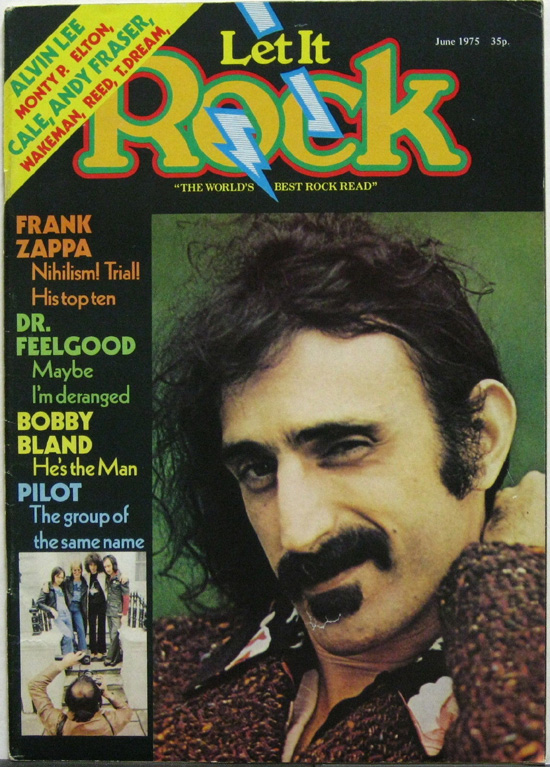
|
|
Creem Magazine 1975

I admit it. The first line of this article was
written a week before the concert: “Having assured
us all most emphatically at Woodstock that he was `Goin´
Home,´ old butter fingers is back…”
Well, it was a waste of time and talent. The fact is
that Alvin Lee has just broken a precedent: not only
is he back, but he’s also better than ever. Claws
in. Next victim, please.
So Alvin’s back. Who isn’t? But it’s news this time.
He’s doing what Eric Clapton wanted to do:
sacrificing lone star status to be one of the boys.
The difference is that Alvin Lee has a strong and
spirited bunch of musicians to play with.They don’t
kowtow, and he has found strength in the challenge.
He has to work for his riffs, and he burns brighter
with every exchange.. |

"I kept telling everybody
I wanted to do
something else!".
|
 The final few moments of every
song are explosive, but never fear, Alvin is in
control now. It’s no longer how many notes he can
play that counts; he’s out to prove how well he can
play them. Quality over quantity at last. Of course he has a lot of help to keep him in check.
Alvin Lee and Company is no small time operation. There are
the two members who have been with him for over a year, the
amazing Mel Collins on various horns, and the dynamic Ian
Wallace on drums. Newer members include Ronnie Leahy who
handles the keyboards, and Steve Thompson on bass. Brother
James is a killer on congas and other percussion instruments,
and Donnie Perki and Juanita Franklin make up the angel’s
choir. |
| That’s a lot of band to handle. Alvin Lee tackles being back
with a vengeance. He does have a mean streak-the meanest
mother in rock and roll, attitude wise. From the moment he
told promoter Howard Stein where he could stick his
spotlights, there was no real doubt that Alvin Lee could
chuck it all, any time. “I’ve done that a few times,” he
says. “I mean I did it after Woodstock. I hid away for about
six months. And everybody said I was mad because the band
could have been out makin´a fortune on the strength of
Woodstock. That big screaming rock and roll circus thing
I’ve always been against.
He may have been against it, but his business associates
and various money men were not. He was subsequently held in
check, which led to his retreat, which led, ultimately, to
his rebellion.
“I kept telling everybody I wanted to do something else! And
nobody would take me seriously, until I said, well, “Here
I’m gonna do it! HERE I COME!! And I’m having to prove the
fact that I’m serious.”
The music ranges now from the mellowest of jazz and
soul-a Junior Walkerish “Freedom For The Stallion,” no
less-to the bluesiest of blues. Alvin’s guitar is at times
supportive, although always with a sting. When he has the
show to himself, he really lets himself go. Letting go now,
however means controlled combustion, there’s more feeling
than flash. Whatever he does is usually right for the moment. For
instance, “Every Blues You’ve Ever Heard” was
and wasn’t. Though it did utilize every blues cliché
imaginable-what blues doesn’t-he couldn’t have made them
seem as urgent or as authentic years ago. That is the
difference-maturity. The precocity has given way to a kind
of raunchy practicality.
He hasn’t abandoned all fun, though. Towards the end of the
show, having pulled off one helluva rock and roll
number,
Alvin, “let fly” with his old freaky fingers act. But
suddenly he crumpled over sideways onto the boards and
rolled on the floor, kicking up his heels, still playing
away, laughing at himself and enjoying the parody
immensely.
The audience was with him all the way-it had been rolling
and rocking in the aisles from the git, and the sudden burst
of insanity from the great scowl face was a welcomed release.
Backstage was a bit less refreshing, at first. It
generally is. Recently L.A. Free Press editor Tim Hogan and
I were stealing food and booze and a few laughs at a
backstage circus for Kiss, and he remarked, “Y´know, as many
times as I’ve been here before, it still feels like I’ve
been here before.” Maybe it’s an inside joke. But it’s
nonetheless true. After a good show, a precedent-breaking
show like Alvin Lee and Co. had put on that night, one
cannot help hoping that perhaps the stars themselves will be
different—that for once the surprise will carry over
backstage as well. It never does. And if experience is the
best teacher, we journalist should know better. There are no
new twists to the backstage promenade.
Alvin was doing his super stud act from bygone days. He’s a
healthy boy, and he likes his women, and doesn’t care who
knows it. With a babe on each knee he posed proudly for
photographs, very much the conquering hero. He’s not sickly
slim or milquetoast white like most British cutie rockers.
He’s rosy and robust: Nordic looking. And he is as
commanding offstage as on. He knows who he is, and to handle
him, it pays to let him know who you are and where you are
as well.
That established, he can be a thoughtful interviewee.
Delightfully cockney, he drops his “aitches” and says “me
self” and “me own,” and takes his time about it. He wants to
make certain that his thoughts are clearly stated. Gets to
the point, “e does. No pussyfootin.”
The point that night was that despite the numerous
encores and grinning critics, Mr. Lee was a bit sceptical
about the performance and spoke right up. Didn’t need to be
asked.
“Yeah…Problem is, tonight we played too loose. Messed around
a bit. Normally we don’t do that. Normally we’re much
tighter.” Reflection, he let up some. “It was the
mood, ý know? The mood of the day. Every night is quite different
because of the crowd, and us, and…”
With a shrug he resigned himself perhaps to the fact that
despite his reservations things had gone well. He has
learned to be easy. Cést la vie—tommorrow, perfection.
Still, this trial run tour was too important for him to
allow for any further foolishness. Alvin is out to find
himself again, and he is very much aware of the fact that
the former TYA legions may not be willing to tolerate the
image exchange. But so far, the audiences have been
receptive; even inspiring. And he was delighted.
“We’ve been out about three or four weeks and it’s
goin´
GOOD!” he grinned. “What’s been nice is getting´ across
acoustic and with jazz band numbers and funky numbers and
all that variety of material. Now, they don’t take it too
well in the backwards places, like… Milwaukee and that. But
we’re playin´ good halls. This tour’s had a concert hall
feel, where everybody can hear and you don’t have…You don’t
get so many policemen clubbing people and that. It’s nicer,
y´know? I really get kind of fed up with doing those big
potty (shitty) stadiums, y´know?”
He got fed up with more than that. Alvin Lee got fed up
with Alvin Lee, and he admits it freely.
Characterising his former self as “Captain Speed Fingers”
(he says that today he’ll settle for being “Captain Gross
Out”), he explained why and how the metamorphosis had come
about. And as he spoke he became oblivious to the backstage
oglers gallery, the flash bulbs, and the hubbub. True
confessions. “I still like…lettin´fly. I still like
that. I
slipped back into it tonight actually. I’ll do that if I
happen to feel that way. I’m not against doing that and I
did, as long as it’s not obligatory…”
He sounded almost defensive; obviously he explained himself
many times, almost imploring spectators to understand.
Almost. Remember, Mr. Lee has a mean streak. There was more
than a touch of “I don’t really give a fuck if you get it or
not” even in his humblest moments. Alvin Lee is, never
forget, his own main man. And that man knows where he went
wrong. “What I originally wanted to do when I started to
play…when I decided to play the guitar, was to be a
musician.
And the rewards of bein´a musician are workin´ with
musicians and playin´ things before, like, small crowds in
clubs or…anyway. Now when it gets to be a habit, instead of
what you want to do, then you’re workin´. “I never found an
outlet for the things I was into. I wrote about thirty new
numbers and never recorded any of them and that’s sort of
frustrating. I couldn’t do that, ´cause it didn’t fit the
format at the time. So I was boxed in. Boxed in by the
audiences…the musicians…by the image.
And I got fed up with everything! All the bullshit. I was
part of the rock and roll machine. Earning money for people.
And…I dunno, I did enjoy it. Originally. But it kinda got to
be like a trap, you know?
The business machine would prefer to have twenty or
thirty percent of Ten Year’s After’s billions and millions
than thirty percent of Alvin Lee and Co.’s hundreds of
thousands. And they said, “Stick with what’s making the
buyer happy, kid.´ It’s common sense. But I don’t believe in
that. Not when it boils down to commercialism. Not for the
sake of it.
I mean, if any of your readers could get paid a thousand
pounds a night for standing on stage having an epileptic
fit, they’d probably do it quite happily for a few years.
But it’s got to get to a point sooner or later where you
ask, “Isn’t there anything more?” He sat back with a
decisive nod. “There is more, and this is what I have to
find out. I didn’t know if people were gonna say “Shut Up”
and yell for “Goin” Home or what, but…like, I got the seven
year itch, musically. So now I’m just experimenting. This is
one experiment. The album with Mylon was another experiment,
and the next thing I do will be another experiment and I
hope to keep changing direction ´till nobody knows where I’m
going. Including me.
“So I…I’m trying to give me-self an unlimited
outlet…unprejudiced outlet. An outlet which doesn’t tie me
down to any one kind of scene. See? It’ll take a couple of
years from now…this is the start. I’m controlling me
records, me own records. I’d like to be able to control me
own concert environment. But this is opening it up you see.
It’s like starting again. Relatively, and I’ve gotta do this
first tour to prove I’m for real.”
The best way to prove that, he believes, is by putting his
music where his mouth is, and so far, that policy has paid
off. He plans to be back in June, to get at more of the
public, to prove that he has grown and intends to keep
growing. He plans to do all this, first of all, and most
importantly of all to him, by giving that public a first
class chance to judge for themselves.
|
|
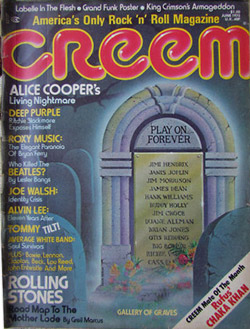
Creem Magazine - June 1975
|
June / July 1975

|
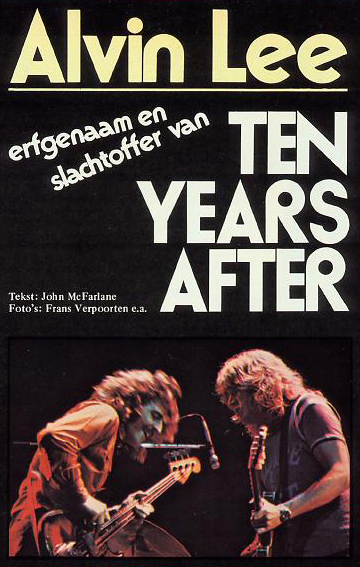
|
|
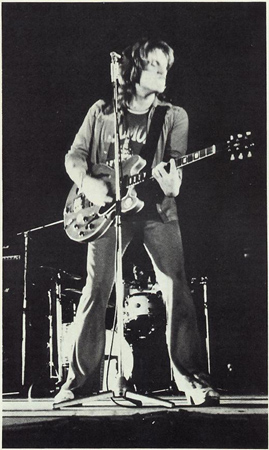
|
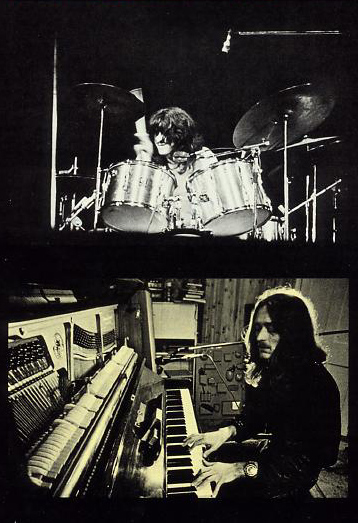
|
|
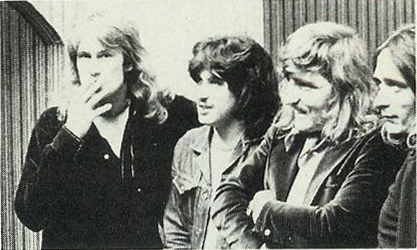
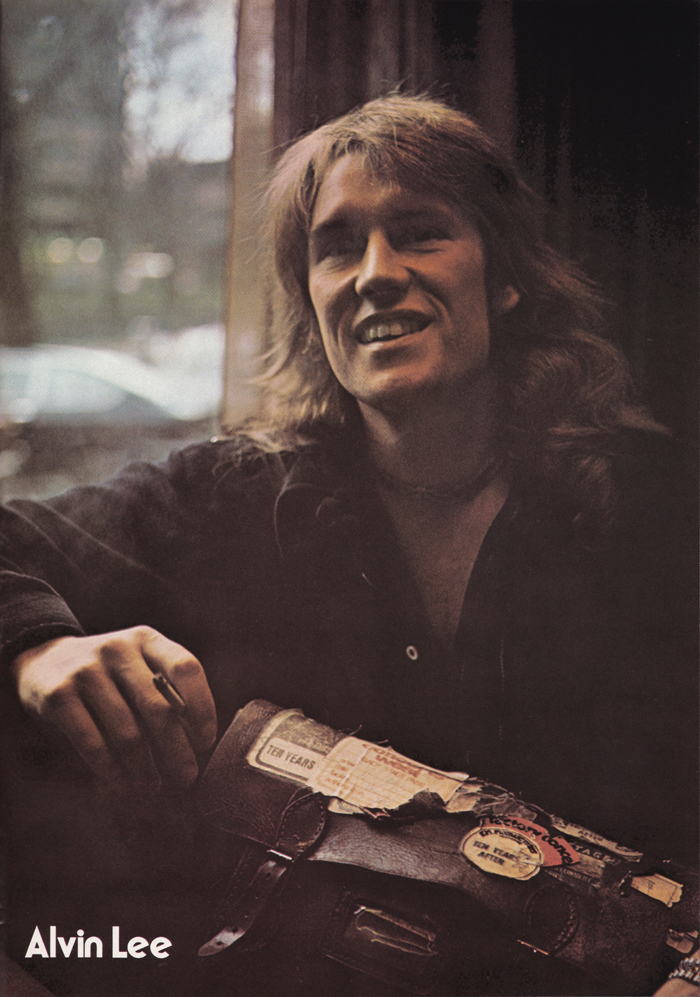
GET IT
- page 49 - Photo: Frans Verpoorten
|
|
1975

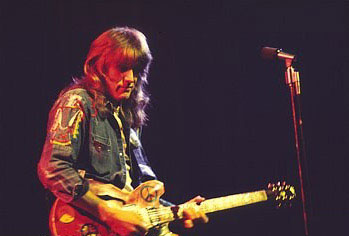
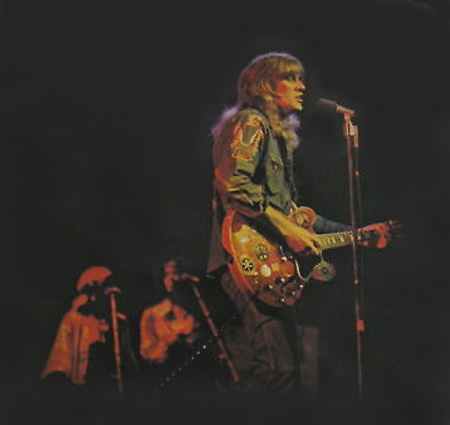
Alvin Lee with back-up singers

On Tour Once Again - 1975
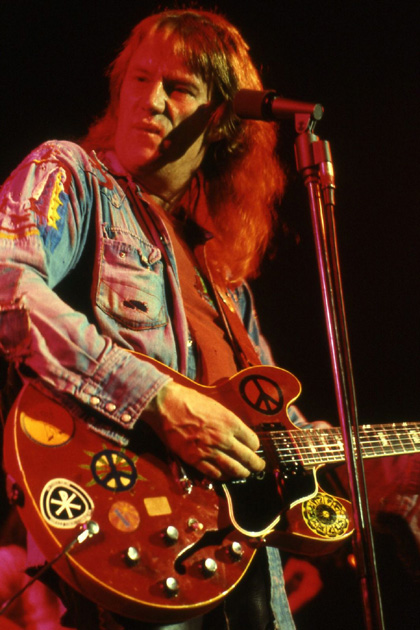
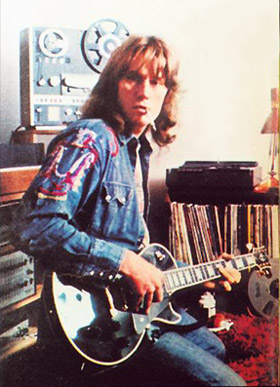
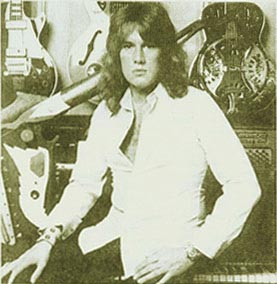
|

Hofheinz Pavilion - 26 July 1975
|
INTERNATIONAL
MUSICIAN and RECORDING WORLD
AUGUST 1975
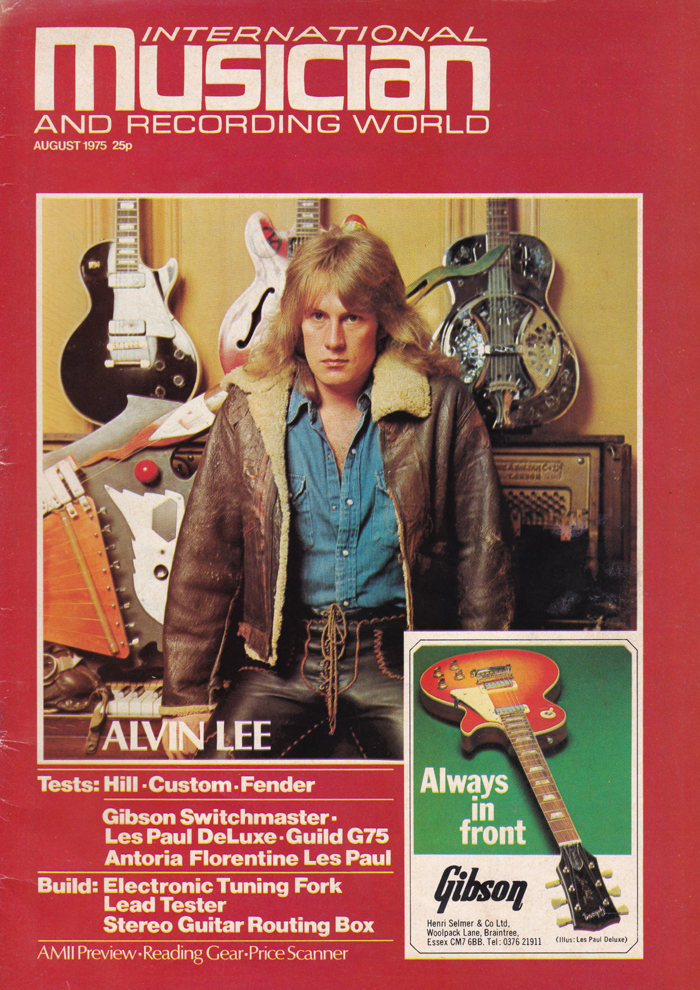
|
ALVIN
LEE
On Fenderising
his Gibson
and
and
varying his technique
|
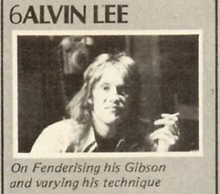 |
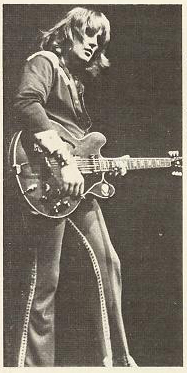

Alvin
Lee is a guitar super hero. He owes his Tudor manor house,
100,000 recording studio and Porsche to the guitar –
usually a Gibson ES335 with an added Fender pick-up.
Q. Alvin,
when did you first add a Fender pick-up to a 335?
- I
did the first one about three years ago (1972) and I
repeated it two or three times since then. I’ve got
three Gibson’s, two for spares and my best.
Q. Did you actually lose anything by putting a
Fender pick-up between the hum-buckers?
A. No, in fact you gain. I now have a Gibson which
sounds like a Tele (Telecaster) just when I want it to. I
left the original Gibson pick-ups on and just added a
Strat (Stratocaster)
backed pick-up between the hum-buckers
which I use without the covers on. I’ve also got
an extra knob so I can have the pick-up out – so it’s
a straight Gibson – or in, so it gets Fenderish. The
centre part of the body is solid and the main contact
comes from the bridge area, the nut and the joint between
the body and the neck, so putting a pick-up in didn’t
affect the sound at all.
Q. Why did you do the job yourself instead of
having someone do it for you?
A. I
did it myself as an experiment really. The first one I did
was out of phase and it was great. Then someone came along
and put it in phase for me and it wasn’t as good. I put
it out again and when I go over to the Fender pick-up the
guitar’s out of phase. It brings the top end up, the
treble.
Q. Did you always experiment with guitars?
A. Yeah. When I was in New York I met Les Paul and
I went over to his studios and that was really incredible.
He had prototypes of every Les Paul he’s ever made
hanging around the walls and there’s a workshop there
where he carves them out, old pick-ups lying around and
everything… He said, “Oh I know you. You’re one of
those types… I work for three years to get the right
sound out of a guitar and you take the capacitors out and
turn the pick-ups round, it happens all the time! He said
“I don’t know why you bother.”

Q. What did you think of his playing?
A. Oh, he’s great. He says now that his playing’s not so
good, arthritis is setting in, but he’s still a major
force so far as being inventive is concerned. He’s into
studios and creating new sounds. The big thing with him is
timbre, he’ll say “That’s a nice tone but I don’t
like the timbre,” so he’s got all these gadgets for
changing the timbre.
He
built the first eight-track recorder, of course. He did it
disc to disc first, he had his own disc cutters. He
recorded a rhythm track on a disc, transferred it from a
disc onto another disc and added the next bit on and so
on. The quality was great.
He’s
been responsible for
so many breakthroughs, like echo – he’s really
incredible. He made the first eight track out of bits like
a Cadillac flywheel and motor.
Q. Have you always been interested in the gadgets
that go with guitars?
A. Not so much the gadgets…in fact, I don’t use
gadgets, I prefer to have the guitar as the sound
generator and the amplifier just for amplification. I
don’t like pedals…and fuzz especially. I prefer to get
fuzz or overload valves rather than fuzz pedals. My own
set up is a 15 watt WEM Dominator.
Q. The one with the pointed front?
A. No, not that one, it’s one Charlie Watkins
made up for me. I have an output from the power amp –
low level, so I get my sound off that. I can mike that on
stage. I take a lead out of the power and I can just put
it through a slave amp and get the sound right. I get the
tone I want and I can get the level from another amp. The
sound I want is valve overload and in fact when WEM were
trying to make me a big amplifier and I was very happy
with my ancient 50 watt Marshall, they had a white coated
boffin analysing the single and he said “The sound you
like is the harmonic distortion of the third octave.” So
I said “OK”. He made about five patents of valve
distortion simulators but none of them worked.
The
thing with a valve…when it distorts, when you overload a
power amp, not a pre-amp, the valves sing – they acquire
their own individual harmonic. You play a chord and it’s
a solid sound, play it through a fuzz and it just
disintegrates into a nasty great grating sound. It’s O.K.
on single strings where you get all that dirty noise in
between the notes.
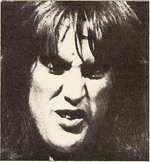

Q. When did you finally get rid of the Marshall?
A. I was working a lot in the studio and when I
started the new band, I didn’t want it to be 1,000 watt
band like Ten Years After, so I used the WEM on stage.
Q. You’re into many other things now, like
management and your studio, but are you still obsessed by
the guitar?
A. Oh yeah, right. Doing all the other things is giving me new
inspiration. Hearing other musicians play, mixing with
other musicians, my whole scene is one of musical
involvement. I went through a period when my music did
stagnate, because I was playing the same stuff over and
over again and I got over that by getting my studio
together, going in and blowing (working / playing) with
different people and experimenting – not making albums,
not recording tracks. Some of the most enjoyable things
I’ve got down on tape are just jam sessions. They’re
not commercial prospects, I don’t think anyone would buy
it, paying $3.50 for 20 minutes of self indulgence on one
chord. But it gets me off.
Q. During your period with Ten Years After when you
were doing the marathon tours of the States, did you ever
get to the point where you never wanted to pick up a
guitar again?
A. Not really. I have acoustic guitar spells where
I can get into country picking and if I was getting fed up
with what I was playing I’d be doing other kinds of
music in the hotel room. Guitar playing should be a hobby.
When one type of guitar playing became a job for me I’d
develop another style of playing as a hobby. I got into
jazz, a bit of classical…
I was actually a student of the guitar, I wanted to
explore as many avenues as possible.
Q. Have you lost that feeling now?
Ah, No, but equalling that feeling now is my concern
with my studio, because that is an extension of my earlier
days of fiddling with gear – even in the very early days
I used to have a 10 watt amp and use it as a pre-amplifier
and power the Vox with that, doubling the tones and so on.
I’m a great believer that it doesn’t have to be
technically right, provided the sound is right. Sometimes
you can feed the whole output of a ten watt amplifier into
a pre-amp stage and risk blowing it up – and get an
amazing sound, providing it last for the take. It gets a
little expensive in fuses though.
Q. Do you still play every day?
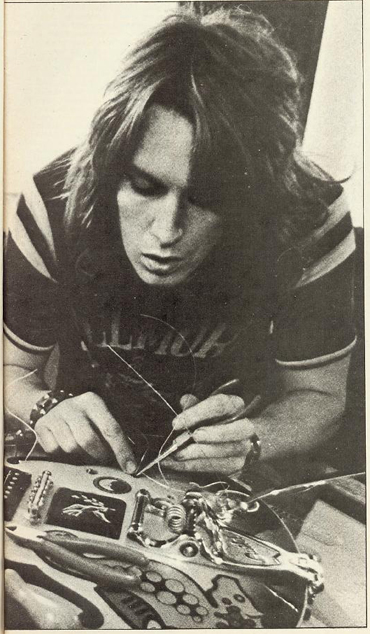
A. Yes. It’s not like practice, I just fiddle
about.
Q. What do you usually play when you first pick up
a guitar?
A. It all depends what instrument it is. If it’s
an acoustic I’ll do a bit of picking. I usually start by
having a whiz around in E, that’s my all-time favourite
key, it gives you perfect coverage of two octaves. G gets
a bit tight, especially on a 335, you get up to G and
it’s difficult to use the top A, through E. You see,
you’ve got to whip down to a bass E and then up to a 12th.
I
play different guitars differently. With a Telecaster,
which gives a tight, nippy sound, I play that style, while
with a Gibson, I tend to wail more on it. I’ve got a
Martin which I pick, and a “Sitar-guitar” which has
its own thing altogether. I’ve got a Melody Maker which
I play bottle neck. Every guitar has its own inclination,
and makes me play slightly different.
Q. Have you played with anyone recently, a guitar
player I mean, who has really astonished you?
A. Ollie Halsall is a very good guitar player. At
one time, I got tagged with the “Fastest Guitar in the
West” title. It was a bit silly really, it was never my
intention, but Ollie can play twice as fast as I can,
twice as clean, and he’s a far better guitarist, he’s
just unrecognised. He’s just over the heads of most
people.
Q. We spoke at length to Richie Blackmore in our
March issue and he was talking at length about your
playing. He said that he was astonished that you play at
the speed you do, and yet you only stroke one way. Do you
stroke up and down continually, or are you basically a
down stroke player?
A. Not completely, no, but in fact I do finger a
lot of notes, the passing notes. I pick the E and I can
apply the G flat and the G without another pick, and
that’s how the notes come in. I do back pick as well, I
tend to back pick on off-beats. It’s more of a
left-handed style, especially the fast stuff.
Q. Do you feel that your right hand is weak, that
it’s your weakest hand?
A. Oh no. No, not really. To tell you the truth,
picking every note on the scale to me sounds like the type
of style that you learn reading music, and not from
listening. I mean to go for an effect of three, I don’t
have a planned technique for how to execute it – I just
throw it around until it sounds good.
Q. Were you always like that or did you go through
periods of trying to improve your clinical technique?
A. Oh, I used to play along with Hank Marvin and I
got a couple of Buddy Holly solos off note for note. What
started to develop when I found Chuck Berry was that,
rather than copy what he was playing, I would play along
and imitate the style but not actually take his licks,
applying my own licks to that feel.
Q. Is that why you originally chose a Gibson?
A. Not really, the reason I played it was that I
got it originally for $45.00 – I was stuck with it!
Q. Now, if I may, I’d like to talk to you about
the studio. Apart from actually just having it, what has
it done to you as a musician, now that you have the
facilities to record instantly?
A. It has spurred me on, I mean, it’s sitting
there, ready to go and all I have to do is have the
material, so it’s spurring me on to get the material
together. The great advantage of it is, for example, if
I’m doing a mix down – like when I mixed the Rainbow
concert it took me two months, on and off, to do that. The
main advantage to that is that if I want tea or if I
don’t know where I’m going, I can turn it off. I can
go out and have a walk, or anything, and come back –
it’s all there, ready to go, you play it again and get
back in fresh. That’s the great advantage, if you rent a
studio and you come back, everything’s changed, you have
to start out all over again.
Q. You talked about your material, how much do you
have at the moment?
A. Well reasonable. I work in spurts. About August
last year, I had a real burst. I write one verse songs,
maybe four or five a week and put them down on tape, and
I’m still about seven cassettes behind, which is about
14 hours of songs which all need second and third verses
and break bridges and choruses and that’s the work,
that’s when I really sit down and lock myself away and
get down to it.
Q. Do you manage to slot song-writing into your
everyday life?
A.
Yeah,
I think I do. I’ve tried sitting sown and saying
“I’m going to write some songs today” but I can’t
do it to order. Another day I’ll be watching TV and
I’ll have to get up and write something.
Q. Of those verse songs, how many do you throw out
when you come back to them?
A. I tend to pick the best. It depends what mood
I’m in. Sometimes I’ll listen to a tape and say it’s
all rubbish, other times I’ll think it’s good. So when
I start a song I really try to finish it, whether it’s
good or bad, because I’ve found that I’m the worst
judge. I have a problem satisfying myself, I’m always
wanting to do something better than before. When I come
back to songs I try to finish them no matter what and if
you still don’t like it when it’s finished, you learn
something by working on it.
|
|
August 1, 1975 - Long Beach
Arena, CA


August 1, 1975 - Long Beach, Los Angeles
 
The following Photos by Stephen
Buffington

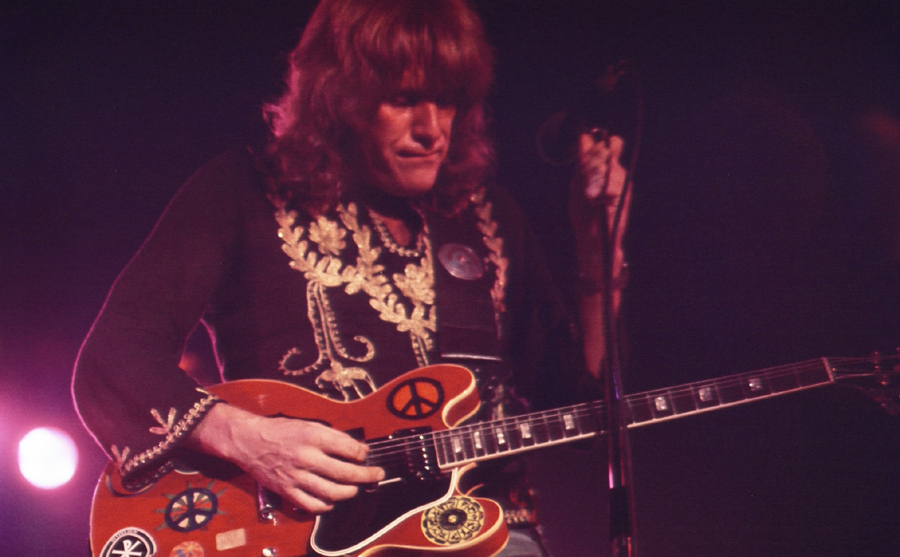
Photo: Steven Buffington

Concert Review published August 23, Record
World
|
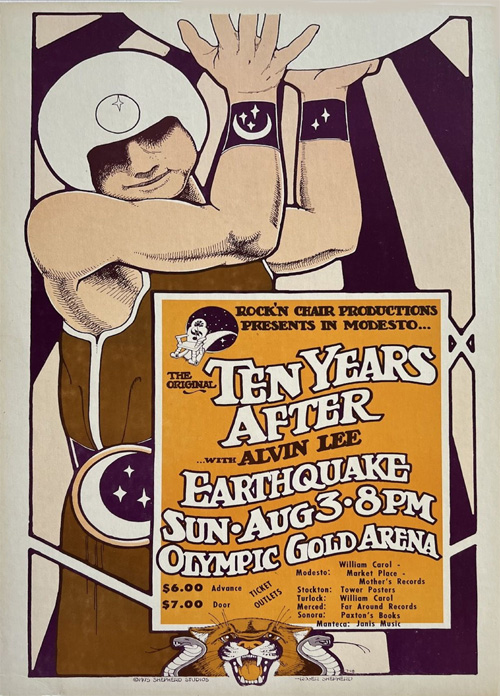
August 3, 1975 - Ten Years After at
Olympic Gold Ice Arena, Modesto, California
Contributions - above and below - by
Christoph Müller
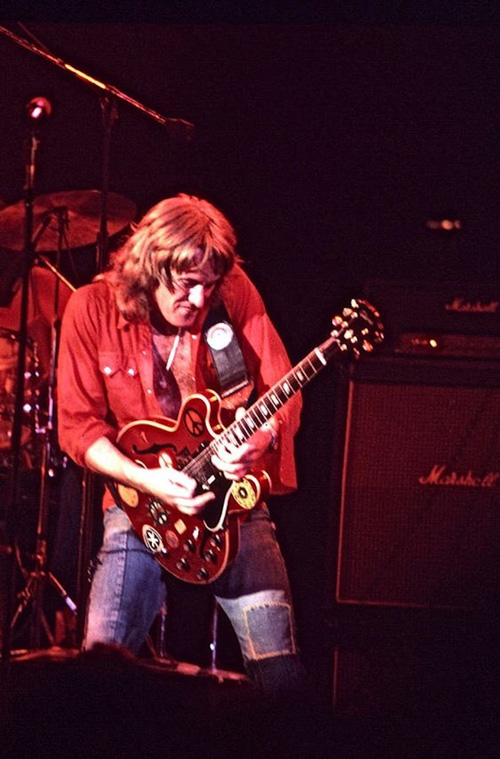
August 4, 1975 - Alvin Lee and Ten
Years After at Winterland, San Francisco
Photographer: Ron Draper

19 August 1975 -
Cobo Arena, Detroit - Photo: David Yurmanovic

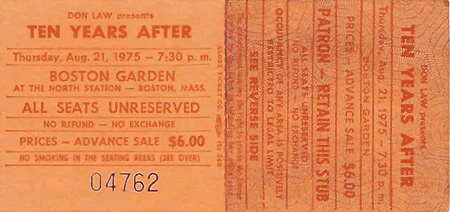
August 24, 1975
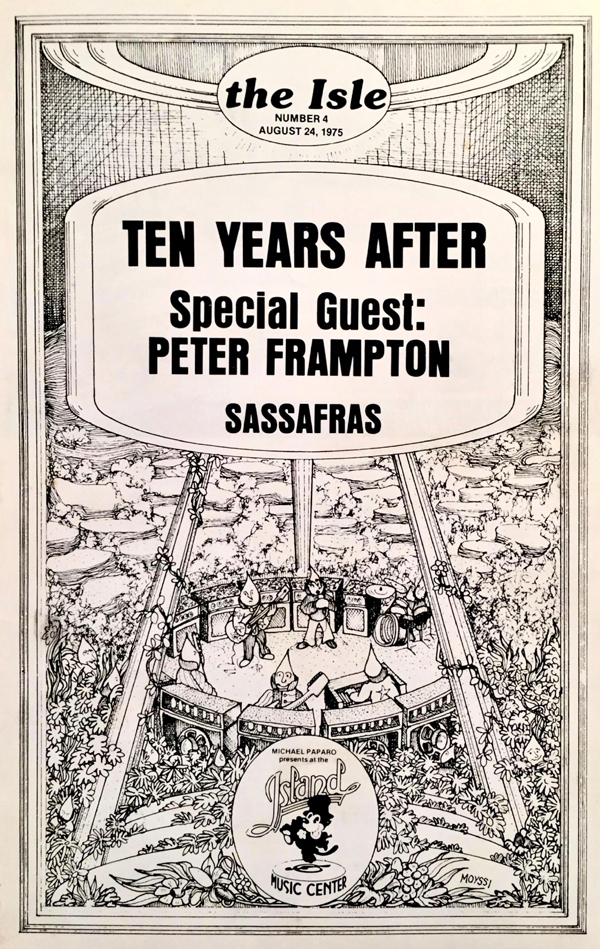
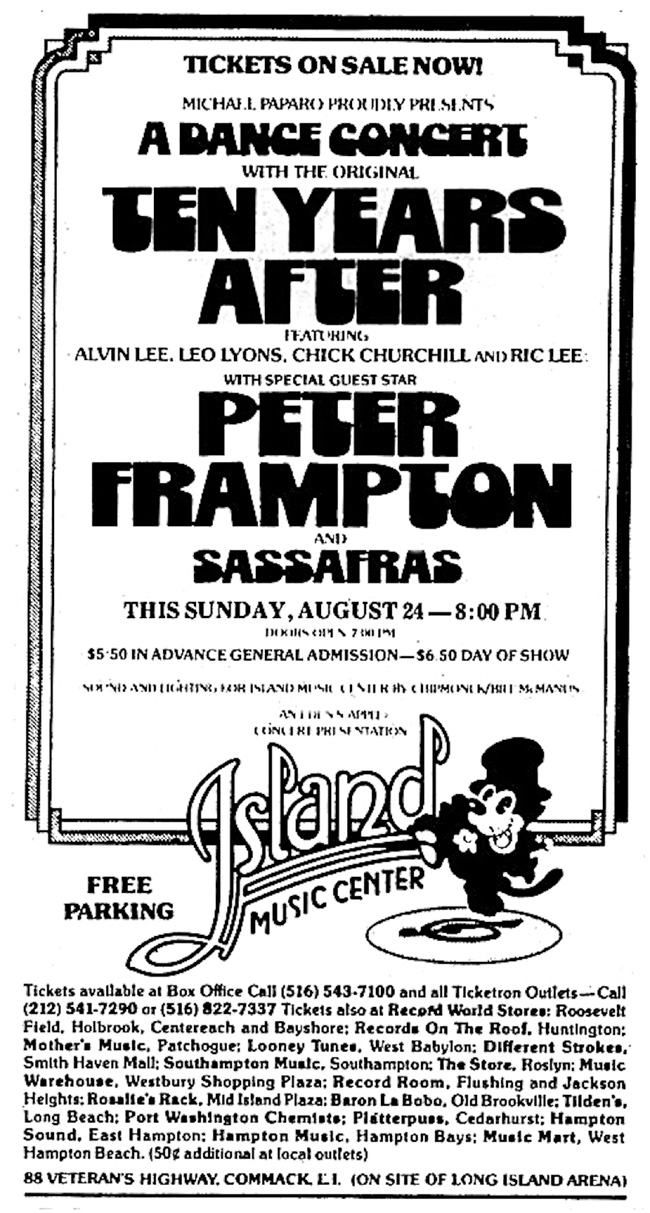
Music Center Commack,
Long Island, N.Y. / Ad in the newspaper "The Village Voice"

August 24, 1975 - Alvin Lee and Ten Years After at
Island Music Center
Commack, Long Island, New York
Photographer: Michael Landskroner

Photographer: P. Jay Plutzer
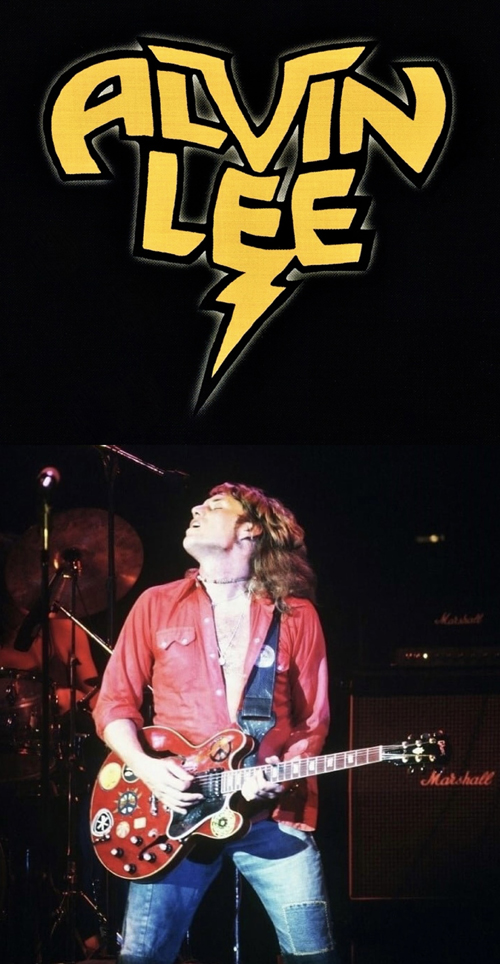
6 September 1975

|
Melody
Maker - September 6, 1975
Alvin Lee – “Pump
Iron” (Chrysalis 1094)
Gotta keep on
keeping on, friends. Keep that old geetar burning hot,
with a variety of subordinate rhythms. That in a phrase,
is the credo or ethos if you like, of young Alvin Lee,
beat king extraordinary. The “Wild Man Of Pop”, has
returned with a selection of performances that would
please any keen student of roll, and indeed rock. If it is
to your taste to tap the old foot, or incline the head at
an appreciative angle, imperceptibly, nodding to the
incessant beat, then this will find a place of honour on
your radiogram turntable. The world of rock seethes with
argument is the song “One More Chance,” the opening piece,
a direct result of the influence of Stevie Wonder upon Led
Zeppelin? Can one detect Afro-American folk culture roots
inherent in such powerful stompers as “You Told Me,” and
“Have Mercy?”
Would one say that
Alvin Lee’s soulful dexterity as a guitarist is dependent
not merely of years of training, but the incalculable
effects of early indoctrination by the works of such
masters as Django Reinhardt. Les Paul and Pig Foot
Blenkinsop, the partially-sighted Texan Blues Legend? One
scarcely need indulge in such high debate, for the music
on this entertaining album is designed not to inspire
controversy , but to unleash a body reaction, straight
from the gut, if not the pancreas. Stomps, shouts and
hollers there are plenty, drums pound, keyboards clank and
throughout it all, wails the Alvin Lee Axe, on which he
performs as if maddened by some intoxicating Eastern
stimulant, or bemused by spirit beings. At least, that’s
the first side of the album.
Elsewhere, we hear
Alvin in a more relaxed mood, joined by Mel Collins at the
soprano saxophone, as on the lightly swinging acoustic
flavoured song, “Time And Space.” Those sour critics who
complain about the lack of “variety” should listen
attentively to these exhilarating passages. And if it is
thought that Alvin tends to “Hog” the proceedings, then
observe the role of his fellow musicians who make a
full-blooded contribution to items such as the immensely
dramatic song called, “Burnt Fungus,” notable for the
sensuous Hammond Organ playing. This is a piece that
reminds me of many nights spent in the Speakeasy,
Cromwellian, Bag O´Nails, Klooks Kleek and Eel Pie Island
during the golden years of British rock, which gave one
such inordinate pleasure. The audience on these “Live”
performances think so as well, and it is my opinion that
the record buying public at large will add their acclaim
and make such a significant purchase, that this disc will
find its way into the popular best selling lists. If not,
then they need their heads examined.
Review by C.W |
7 September, 1975

CIAO Magazine, No. 34/35
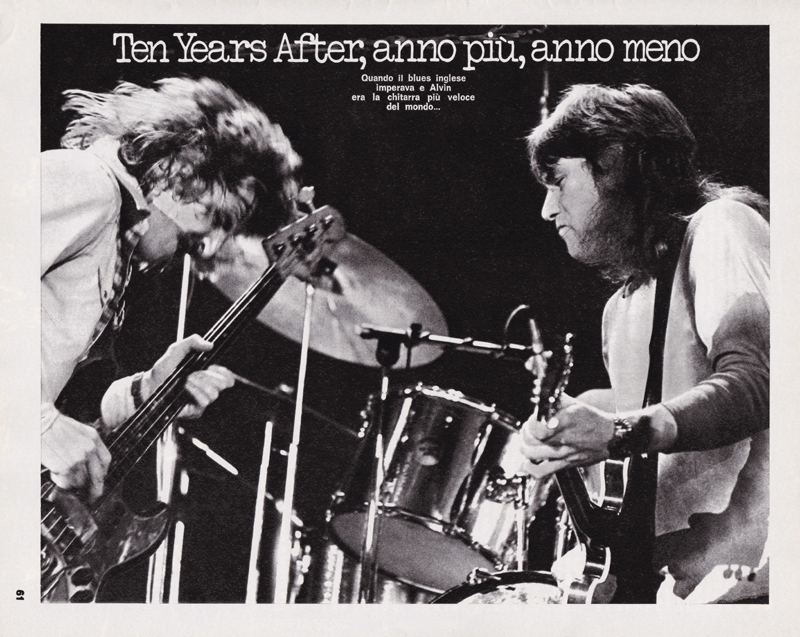
pages 61 and 62

5 October, 1975
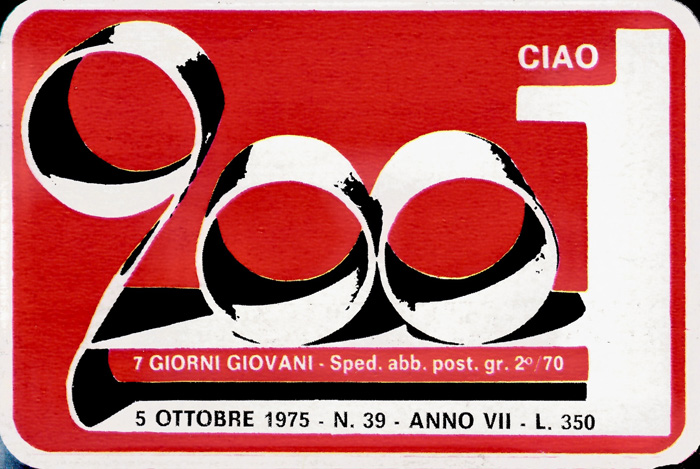
Italian magazine "Ciao2001", No. 39,
pages 1 and 2
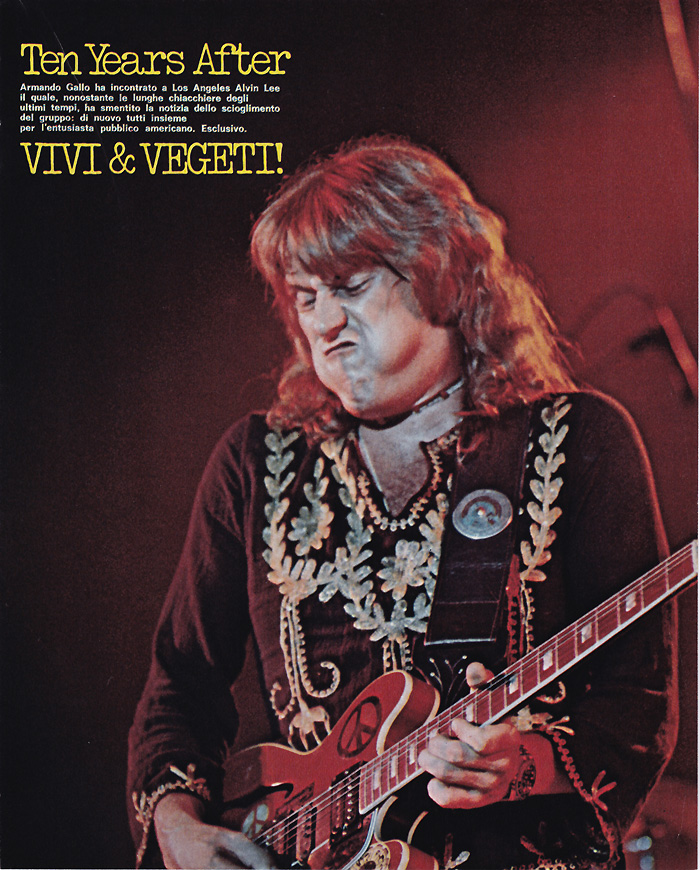

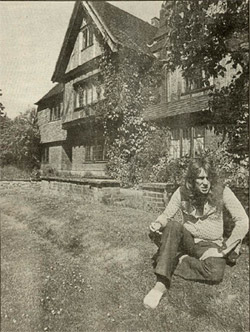

From October 11, 1975 – Sounds
By John Ingham – At Hookend Mannor
To visit Alvin Lee at home is seemingly to see a man
living the perfect fantasy life – 40 room mansion, large
gardens, recording studio, colour darkroom, and all the
gadgets and toys that makes living in the Twentieth Century
so much fun.
Waking up in the late afternoon, he had lain in bed watching
“Abbott and Costello Go To Mars”. Now he was ensconced in
the TV / Video room, a wood panelled room whose only centre
of focus was a large television. Beside it stood a very
sophisticated VCR and video camera. Alvin likes to make
videotapes; he’s preserved several concerts for posterity.
We watched a cassette of Ali’s Manila Killer and then
retired to the sound / film room, passing an enormous r/c
glider lying in a window bay. Everywhere you looked rooms
extended the spaces occasionally intersected by comfortable
furnishings; but unlike Kane’s Xanadu, very comfortable.
This second media room is dominated by a Tannoy Malorcan in
each corner, though Alvin dismisses quad. A dobro and guitar
lean against a speaker, records range along one wall. An
alcove holds a slide and 16mm film projector standing on top
a bench stacked with cassettes of slides. A fire burns in
the grate. In the middle of the room a clump of beanbags
cushions in American and Russian flag covers await the
body’s pleasure. It is here that Alvin writes most of his
songs.
DISTRACTIONS:
But is it the perfect life after all? “It’s great to have
everything you want, but in a way you’ve got more problems.
You’ve got everything you always wanted and you think. “I
should be in the best environment in the world.” You wake up
in the morning and you’re not feeling too good, in some ways
it’s worse, because you play pinball and then snooker, ride
the bike around the garden, and you’re still feeling wrong.
What I need to do then is work and make myself sit down, but
sometimes there are too many distractions. That pinball
machine – Christ!”
We should all have such problems. I’d been wanting to corner
Alvin for a couple of months. He had told me in an interview
that he doubted Ten Years After would ever reform,
regardless and / or because of individual pursuits. He
hadn’t even talked to them on the phone since the break up.
A month later a TYA tour of America was announced. Something
sounded amiss, something I wanted to get to the bottom of.
But first… “Pump Iron”, the new album. Given a
deadline,
Alvin had sifted through the tapes that continually
accumulate in his studio, either as glorified demos with
himself on all instruments (his drumming is hilarious) or in
sessions built from combinations of the familiar names on
the back cover. Usually, lyrics were one verse and a chorus
or less.
DEADLINE:
With things in reasonable shape, drummer Ian Wallace was
called in for one of his spectacular overdub sessions,
slotting himself into tracks that were otherwise complete.
Later, Boz arrived to perform the same function on other
tracks. It was finished at 10 pm the night before the
deadline.
An eclectic album, it ranges the gamut from an electronic
Sargasso Sea, wherein Alvin mixed down about 50 tracks of
noises, bleeps and whirrs, to Alvin Lee and Co. taped live
at New York’s Academy of Music, which prompted him to
construct various songs across that side of the record as
though they were being recorded in similar situations.
Although this isn’t the projected “Chuck Berry album”
Alvin’s been threatening us with, the same sentiments
exist.
“A lot of music now I find leaden and boring, overdone.
Whereas a lot of the old rock and roll was really subtle—you
used to think it was going bash bash but in fact it wasn’t.
That was what I basically got tired of in Ten Years After,
the whole format and attitude of overplay. It worked for the
audience—if you hit them in the teeth hard enough they’re
bound to notice you. I’ve gotten out of it but I don’t
underestimate its effectiveness. There are so many tasty
musicians who don’t get anywhere. If Ten Years After had
been like that we’d probably have been appreciated, but no
one would have said, “Cor, have you seen this lunatic who
plays eight billion notes a minute?”
There—it was out. Is any Alvin Lee interview possible
without mentioning TYA, or for that matter, Woodstock”?
Unbidden, the magic names hove into view.
“Ten Years After grew into something I didn’t want—the heavy
rock image thing, and we really tried to keep out of that.
But it happened anyway through “Woodstock”, which was a
complete accident, and it really changed a lot of people’s
attitudes to what we were doing. Before then it didn’t seem
so important, just go out there and have a good blow and get
people off. Suddenly, it was really big gigs. Gotta play
note for note. The fun seemed to disappear when the audience
got to 12,000…15,000.
ACQUISITION:
“It wasn’t too important to me or I wouldn’t have given up
doing it. I just really needed a break from that whole trip.
It was a good one after the days of starving and in a van up
and down the M1. Then the success and the acquisition of
worldly goods—gotta do that one, finding out that’s not all
it’s cracked up to be. This is one of the things that
strikes me; you sit down and think—especially if you’re
moving and progressing in what you’re doing, the band is
successful –you think, “This is a good opportunity, what do
you want to do with it?” And you work out a basic plot---get
a good house with a studio, plenty of rooms. And then
reality.
“You don’t wake up every day and say this is incredible,
because you get used to it and things still go wrong and
pipes burst. It’s all relative. I used to live from hand to
mouth on six pounds a week and spend eight. It’s the same
now except it’s in thousands. I won’t get into business at
all. I hate it. Accountants saying you must save and invest
in bonds and me saying bullshit. “The funny thing was I
didn’t even want to make any money, particularly. My
original motivation wasn’t to be a rock and roll star and be
rich and famous, it was to be a musician, and it just went
into that.”
Listening to all this in a mansion stuffed with the tools
and toys Alvin finds essential to his existence was a bit
weird, but since arguments based on the notion that “It’s
easy for you to dismiss material wealth” seemed trivial, the
subject wasn’t pursued. Rather, I tracked down Alvin’s solo
projects, which usually start off as hobbies until he begins
to think he could perhaps tailor them towards more
productive and realistic projects.
FBI he first saw on “Magpie” one afternoon, where they
announced that they had neither record company or manager.
He contacted them, offered the use of his studio, and has
been intimately involved ever since. A recording contract is
currently being “lawyered over”, and Alvin plans on taking
them with him on his next tour in February, 1976. Whether
this will be in Britain has yet to be decided.
Concomitant with his love of video, Alvin is also supplying
the soundtrack for a projected film on Atlantis by “2001”
computer animation wizard Jack Knight, using (your best
basso announcer voice, please) computerised animation
equipment never before used in the history of motion
pictures.
LAWYER’S MILL:
That is, he will be working on it but “it’s still in the
lawyer’s mill, know what I mean? Dee, my business manager
will ring when it’s all fixed and say, “Okay, go.” I’m quite
proud of my system now. If someone calls up and asks if I
want to do something I say sure, because I don’t have to
worry about the wheeling and dealing, my business manager
sorts it out. If it were to be a good film and do well, then
somebody somewhere will make a lot of money out of it and
therefore each share has to be worked out.
“I’ve been reading up on Atlantis…I think it’s best to
interpret it—keep the mystery, because when you see what it
actually was, it wasn’t that groovy. Wars like everybody
else.” Do you believe in all that? “I don’t not
believe. I
very rarely make my mind up about anything because I change
it so many times. I was once told my failing as a rock star
was that I had nothing to say to people; that I’m not a
preacher. But you can’t really help the world by telling
them what you think.” Enough of this dilly-dallying ---it
was time to take the bull by the horns. Alvin, a few months
ago you told me you hadn’t even talked to your compatriots
and the next thing….
WHY NOT?
“Ah, yes. I went to Los Angeles on August 14 to cut my
album,
still not sure whether the tour was going to come off
because of a lot of business hassles…lawyers again.” One
gets the impression Alvin doesn’t like lawyers. “So I went
prepared to do it whether I got paid or not. I knew Leo
(Lyons) would be there because he had come down one
afternoon and talked about it and I said, “Yeah”. Why
not?
But the others were unknown quantities. So I flew to
Birmingham, Alabama, on the 17th, the band arrived from
England that evening and went straight to bed, and we met
the next day for the first time in 14 months.
“We decided what numbers we wanted to play on the way to the
gig, which was a racetrack. By the second number of our
rehearsal it started raining and we ended up blocking out
numbers in a trailer, with one amp. Went on that evening and
did a great set. It was like turning the old switch on again.
By the fourth night we were playing as well as we’ve
played,
but we were more enthusiastic than we had been for years.”
Just like that? It seemed a bit prosaic. Weren’t financial
aspects a prime motivation? “Yes and no. It was a prime
motivation to get the band out. But I made a decision that I
wanted to do it for fun rather than---well, we haven’t been
paid for the tour, and we didn’t expect to because of all
the lawyers. Business people…”
It was the question, why America? (as if we didn’t know)
that revealed all. Due to the American recession, only safe,
established bands were a guaranteed gate. Ergo, while it was
a bad time for an Alvin Lee and Co. tour, it w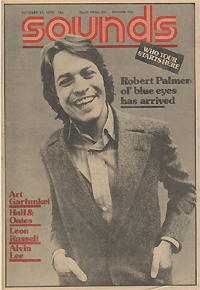 as good for a
TYA tour. Manager Chris Wright performed the actual
persuasions. As for future tours, Alvin reckons they’ll be
very widely spaced, if at all. as good for a
TYA tour. Manager Chris Wright performed the actual
persuasions. As for future tours, Alvin reckons they’ll be
very widely spaced, if at all.
Even on the road Alvin had kept it all in perspective. In
Nashville earlier this year he had wandered through Earl
Scrugg’s tenth anniversary album, rubbing shoulders with
Bonnie Bramlett, Charlie Daniels, Tony Joe White, Linda
Ronstadt and an army of other liggers. In Los Angeles, he
had jammed with the Scrugg’s Revue, noting that when they
were really cooking they’d look at each other and perhaps
tap a foot.
Back near Music City he had been invited to the second
annual Charlie Daniels jam-boree and festival, which
showcased just about every Southern musician from the
Allmans down. That Alvin was the first outsider to be
invited onstage you may interpret as you wish.
It being such a fashionable subject, there seemed only one
question left. Are you one of the exalted 90 percent taxed?
“Not really. I don’t make a lot of money myself, it all gets
used up before I get any. I’m staying by choice—I could live
in Vienna and not be paid for doing a tour; I might as well
live here and not get paid.”
|

New Musical Express 10/ 18/ 75
Alvin Lee: Pump Iron (Chrysalis)
Alvin Lee may be a nice bloke, but all his taste’s in his mouth.
“Pump Iron” is a great title, except that Lee’s familiar
alchemy transmutes the iron into lead. He has assembled a band here around the potentially excellent drummers Bryson Graham
and Ian Wallace with Bad Co’s Boz on bass. The formidable Mel Collins and Jack Lancaster take care of
horns,
while Ronnie Leahy (formerly of Stone The Crows) plays organ. At various
points Boz is traded in for either Andy Pyle or Colin Gibson, whilst at
others Ron Berg plays drums.
Side
one opens with “One More Chance” a plodding cement-like attempt at
black funk bisected by a totally
undistinguished
solo by Lee. “Try To Be Righteous” is a limp-wristed reggae with
extraneous acoustic guitars and redundant chord changes. Occasionally flat.
“You Told Me” is “One More Chance” played backwards, while “Have
Mercy” is a
mid
paced blues bursting at the seams with clichés.
“Julian
Rice” closes the first side with all the verve of a sloth on mandrax.
Side
two is similarly forgettable; Lee is apparently unable to pull out one
single decent riff. The sidemen all
Sound
totally bored; they seem similarly incapable of providing anything of
intrest.
I
really cannot fathom how Chrysalis allowed themselves the extravagance of
releasing this album. “Pump Iron”
is
one of the most redundant albums I’ve ever heard.
Pure tapwater.
Pete
Erskine

|
|
Rolling
Stone Magazine 11 / 75
Pump
Iron - Alvin
Lee
Columbia PC 33796
Since
divesting himself of the other members of Ten Years After, Alvin Lee’s
music, both here and on the previous
In Flight, has taken on a stronger R & B feel and focused on his vocal
abilities as much as his guitar.
Pump
Iron follows the same pattern as it’s predecessor –a solid upbeat –R
& B meets Anglo-flash format with Lee backed by well-known friends (Boz
Burrell, Ian Wallace, Mel Collins and others) who perform with restrained
expertise.
Lee
still spins a few “Goin’ Home” riffs (“Burnt Fungus”) and even
adds a love song (“The Darkest Night”) but
most
of this album is white, English and hard. Those who remember Lee only as
the finale to the movie Woodstock
may
find the diversity of Pump Iron appealing.
By
Alan Niester

|
|
Melody
Maker Magazine
Alvin
Lee - “Pump Iron”
(Chrysalis
CHR 1094)
Gotta
keep on keeping on, friends. Keep that old geetar burning hot, with a
variety of subordinate rhythms.
That,
in a phrase is the credo, or ethos if you like, of young Alvin Lee, beat
king extraordinary.
The
Wild Man Of Pop, has returned with a selection of performances that would
please any keen student of roll,
And
indeed rock.
If
it is not to your taste to tap the old foot, or incline the head at an
appreciative angle, imperceptibly, nodding
to
the incessant beat, then this will find a place of honour on your
radiogram turntable. The world of rock
seethes
with argument. Is “One More Chance” the opening piece a direct result
of Stevie Wonder upon Led Zeppelin?
Can
one detect Afro-American folk cultural roots inherent in such powerful
stompers as “You Told Me” and
“Have Mercy?” Would one say that Alvin Lee’s soulful dexterity as a
guitarist is dependent not merely of
years
of training , but the incalculable effects of early indoctrination by the
works of such masters as
Django
Reinhardt, Les Paul and Pig Foot Blenkinsop, the partially-sighted Texan
blues legend? One scarcely need indulge in such high debate, for the music
on this entertaining album is designed not to inspire controversy, but
to
unleash a body reaction, straight from the gut, if not the pancreas.
Stomps,
shouts and hollers there are a plenty, drums pound, keyboards clank and
throughout it all, wails the Alvin
axe on which he performs as if maddened by some intoxicating Eastern
stimulant, or bemused by spirit
beings.
At least that’s the first side.
Elsewhere,
we hear Alvin in more relaxed mood, joined by Master Mel Collins at the
soprano saxophone, as on the
Lightly
swinging acoustic flavoured “Time And Space.” Those sour critics who
complain of lack of “variety”
Should
listen attentively to these exhilarating passages. And if it is thought
that Alvin tends to “hog” proceedings
Then
observe the role of his fellow musicians who make a full-blooded
contribution to items such as the immensely dramatic
“Burnt
Fungus” notable for the sensuous Hammond organ playing. This is a piece
that reminds me of many nights
spent
in the Speakeasy, Cromwellian, Bag O’ Nails, Klooks Kleek and Eel Pie
Island during the golden years of British
rock,
which gave one such inordinate pleasure.
The
audience on these “live” performances think so as well, and it is my
opinion that the record buying public
At
large will add their acclaim and make such a significant purchase that
this disc will find its way into
The
popular best selling lists. If not—then they need their heads examined.
By
C.W.
|

|
|
|
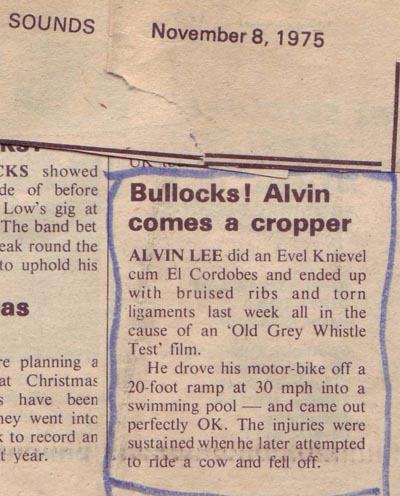
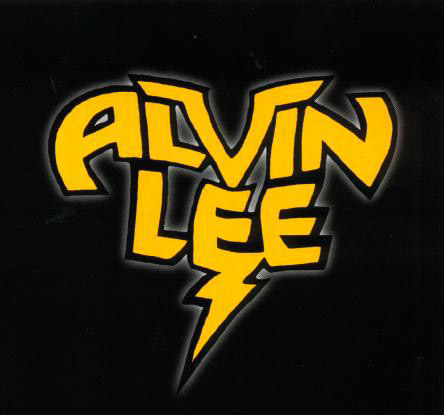
|
|